
About UsThe Numismatic Bibliomania Society is a non-profit organization devoted to the study and enjoyment of numismatic literature. For more information please see our web site at coinbooks.org SubscriptionsThose wishing to become new E-Sylum subscribers (or wishing to Unsubscribe) can go to the following web page link MembershipThere is a membership application available on the web site Membership Application To join, print the application and return it with your check to the address printed on the application. Print/Digital membership is $40 to addresses in the U.S., and $60 elsewhere. A digital-only membership is available for $25. For those without web access, write to: Terry White, Treasurer
AsylumFor Asylum mailing address changes and other membership questions, contact Terry at this email address: terrywhite5475@yahoo.com SubmissionsTo submit items for publication in The E-Sylum, just Reply to this message, or write to the Editor at this address: whomren@gmail.com BUY THE BOOK BEFORE THE COINSale Calendar |
- WAYNE'S WORDS: THE E-SYLUM MARCH 26, 2017
- NEW BOOK: 1792: BIRTH OF A NATION'S COINAGE
- NEW BOOK: COLLECTING FLORIDA NATIONAL BANK NOTES
- NEW BOOK: GRAND CATALOG OF AUSTRALIAN AND OCEANIAN COINS
- NEW BOOK: WORLD PAPER MONEY, MODERN ISSUES, 23RD ED.
- EL SITIO NO. 22 PUBLISHED
- DEXTER 1804 DOLLAR POSTERS OFFERED
- BOOK EXCERPT: FINANCIAL FOUNDING FATHERS
- NEWMAN PORTAL DIGITIZES EDGAR ADAMS DOCUMENTS
- NUMISMATISTS WHO WERE ALSO PAINTERS
- HARVEY STACK RECALLS THE PHILIP SHOWERS SALE
- NOTES FROM E-SYLUM READERS: MARCH 26, 2017
- VOCABULARY TERM: INTERRUPTED REEDING
- WAYTE RAYMOND (1886-1956)
- U.S. MINT PRINCIPAL DEPUTY DIRECTOR RHETT JEPPSON
- RESEARCHING SS CENTRAL AMERICA'S CARGO
- THE NEW ENGLAND GOLD HOAX OF 1898
- POGUE V SALE AT EVERGREEN THIS WEEK
- THE POGUE FAMILY COLLECTION AND EPIC PAST SALES
- 1795 DRAPED BUST DOLLAR SELLS FOR £28,000
- SELECTIONS FROM THE SHAW & BETTENCOURT SALE
- NUMISMATIC NUGGETS: MARCH 26, 2017
- STATE DEPARTMENT MEDAL GOLD MEDAL OFFERED
- SPINK USA OFFERS PAQUET AND WRIGHT MEDALS
- ARCHIVES INTERNATIONAL SALE 40 ANNOUNCED
- SELECTIONS FROM ARCHIVES INTERNATIONAL SALE 40
- RARE COENWULF PENNY FOUND BY METAL DETECTORIST
- JERUSALEM BYZANTINE COIN FIND
- MONTGOMERY BLAIR RUSSIAN WIRE MONEY
- MORE ON THE NETHERLANDS LION DAALDER
- STACKS BOWERS OFFERS CHOPMARKED TRADE DOLLARS
- ORDER OF THE BRITISH EMPIRE MEDAL FOUND
- MORE ON THE NEW ONE POUND COIN
- LIBERIA STRUGGLES TO REPLACE WORN BANKNOTES
- CHINA BUS COMPANY PAYS DRIVERS SMALL CHANGE
- NEW YORK PUBLIC LIBRARY UNDERGROUND STORAGE
- BEP LAUNCHES NEW SOCIAL MEDIA ACCOUNTS
- FEATURED WEB SITE: MONEY GRAFFITI
Click here to access the complete archive
To comment or submit articles, reply to whomren@gmail.com
Content presented in The E-Sylum is not necessarily researched or independently fact-checked, and views expressed do not necessarily represent those of the Numismatic Bibliomania Society.
WAYNE'S WORDS: THE E-SYLUM MARCH 26, 2017
 We now have 2,910 subscribers. Thank you for reading The E-Sylum. If you enjoy it, please send me the email addresses of friends you think may enjoy it as well and I'll send them
a subscription with your compliments. Contact me at whomren@gmail.com anytime regarding your subscription, or questions, comments or suggestions about our
content.
We now have 2,910 subscribers. Thank you for reading The E-Sylum. If you enjoy it, please send me the email addresses of friends you think may enjoy it as well and I'll send them
a subscription with your compliments. Contact me at whomren@gmail.com anytime regarding your subscription, or questions, comments or suggestions about our
content.
This week we open with four new books, one new periodical issue, a reproduction of a rare numismatic print, and an excerpt from a book on America's Financial Founding Fathers.
Other topics this week include the State Department lifesaving medal, Russian wire money, the Netherlands Lion Dollar, chopmarked trade dollars, Edgar Adams, Philip Showers, Wayte Raymond, Rhett Jeppson, Tommy Thompson, Anthony Paquet Charles Cushing Wright, and money graffiti.
To learn more about the coinage of 1792, Florida National Bank Notes, the Dexter 1804 dollar, the first Bank of the United States, numismatists who paint, dropping a dime, Bar Mitzvah medals, interrupted reeding, the Charleston Company of Volunteers medal and coin porn, read on. Have a great week, everyone!
Wayne Homren
Editor, The E-Sylum
NEW BOOK: 1792: BIRTH OF A NATION'S COINAGE
 1792: Birth of a Nation's Coinage (softcover)
1792: Birth of a Nation's Coinage (softcover)
Written by Pete Smith, Joel J. Orosz, and Len Augsburger
1792: Birth of a Nation's Coinage is the long-awaited research-based study of the 1792 coins, which were produced during the first six months of the U.S. Mint's existence. These cents, half dismes, dismes, and mysterious eagle-on-globe pieces, have been little studied and long misunderstood. In the 225 years since they were struck, mysteries have accumulated around them. Legends have explained their origins, arguments have raged over their status, and wild guesses have been taken about their rarity.
1792: Birth of a Nation's Coinage begins with the "prehistory" of the Mint, covering the legislative debates leading to the passage of the Mint Act in April of 1792, and the concurrent experiments in coinage by private individuals seeking government coinage contracts. The book does not solve every mystery about the coinage of 1792, but it does debunk some myths (George and Martha Washington's silver service was not melted to strike half dismes); settle some arguments (half dismes are regular issues, not patterns); and defines the rarity of each issue of 1792 (a detailed census of every locatable specimen is provided, along with each coin's pedigree). Along the way, many new facts and insights are revealed; for instance, while Washington did not provide the silver to strike half dismes, another future President did!
Whether you are a collector, a dealer, a cataloger, or just fascinated by the enigmatic coins that serve as a bridge between the colonial, state, and Confederation issues that went before, and the myriad federal issues that have followed, 1792: Birth of a Nation's Coinage is a must-read book.
For more information, or to order, see:
1792: Birth of a Nation's Coinage (softcover)
(https://coins.ha.com/itm/books/1792-birth-of-a-nation-s-coinage-softcover-/i/960011813.s)

NEW BOOK: COLLECTING FLORIDA NATIONAL BANK NOTES
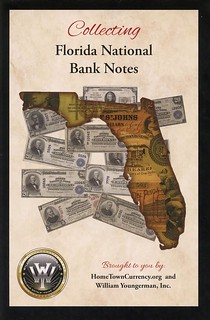 Jonathan Beach of William Youngerman Inc. writes:
Jonathan Beach of William Youngerman Inc. writes:
The booklet includes the most accurate census for all 109 charters, color photos of notes from each town, articles, the chronology of building the largest Florida NBN collection, What is a National Bank Note?, The Fort Meade Story, and a check list for collectors.
Chronology of building the largest collection.
Sen. Warren Henderson begins collecting Florida currency in the late 1950's. His collection is greatly expanded by the purchase of the Clarence Criswell collection in 1968 and the Harley Freeman collection of Florida Nationals in 1970. In 1971, Henderson purchased the George Nicholson / George Decker Florida collections. These collections brought the total National Bank Note collection to 227 notes (118 large and 109 small).
By 1977 the collection would total 251 nationals.
In December 1986 Henderson through Harold Johnson's efforts sold the collection to Barnett Banks of Florida. The collection had at that time 264 National Bank notes plus hundreds of state, territorial and obsolete notes and scrip.
In February 1998, Barnett Banks were sold to Nations Bank (now Bank of America). In August, 1998 the collection was gifted to the University of Florida. In September 1998, the collection was sold to Barnett Bank's last president and COO Allen Lastinger, Jr. Lastinger continued adding to the collection from 1998 until his sale of the collection to William Youngerman, Inc. in 2013.
William Youngerman started his collection of Florida currency in 1992 purchasing many of the known collections of Florida currency over the next 20 years with the dreams of merging the two great collections together one day. That dream was fulfilled in November 2013. With the two collections finally merged together for the first time in history all 59 towns issuing National Bank Notes are together along with all 102 known charters of the 109 chartered banks that issued currency in Florida.
For more information, or to order, see:
www.williamyoungerman.com
To read the earlier E-Sylum article, see:
FEATURED WEB SITE: FLORIDA CURRENCY (www.coinbooks.org/v20/esylum_v20n12a32.html)

NEW BOOK: GRAND CATALOG OF AUSTRALIAN AND OCEANIAN COINS
 Grand Catalog-Book of Australian and Oceanian Coins 2000 - 2017
Grand Catalog-Book of Australian and Oceanian Coins 2000 - 2017
Format-A4
Pages
350 Coins
8500 Pictures
Author Lukasz Rosanowski
It took three years to create the catalog. The catalog was created in a response to an enormous and continuously increasing interest and demand of coins.
The catalog aims at:
- Issuing price
- Promotion of numismatics and collecting
- Promotion coins from Australia and Oceania
- Providing information and knowledge about coins
- Increase of prestige of coins from this part of the world since this is the first catalog of this kind
- Gathering all coins in one place so the current and future generations have an easy insight
The Grand Catalog was created with the newest Australian and Oceanian coins in mind. It aims at discovering and ordering coins from this part of the world. Those coins take up universal and diverse topics, providing lots of emotions which is why they are collected by collectors all over the world. They distinguish in low mintages, beautiful and meticulous accomplishment with the usage of the newest mint techniques. Without a shadow of a doubt those are the most beautiful and elite coins of the world.
Content:
The catalog includes 8500 circulation, commemorative, bullion and collector coins from Australia, New Zealand, Niue, Cook Islands, Tuvalu, Fiji, Palau, Tokelau, Papua New Guinea, Nauru, Solomon
Islands, Samoa, Kiribati, Vanuatu etc. Those coins were minted in: Perth Mint, Royal Australian Mint, New Zealand Mint, Mint of Poland, PAMP, Royal Canadian Mint, Mint of Finland, Mayer Mint,
Helvetic Mint etc. They were accomplished with the most developed techniques. The catalog consists of three parts: Series, Bullion coins, Countries. It took three years to create the catalog. It is
the most complete and a vast catalog concerning coins from this part of the world.
Circulation is up to 5000 copies.
For more information, or to order, see:
Grand
Catalog-Book of Australian and Oceanian Coins 2000 - 2017
(https://firstcoincompany.com/S/grand-catalog-book-of-australian-and-oceanian-coins-2000-2017-format-a4-pages-350-coins-8500-pictures-12000-isbn-number-author-lukasz-rosanowski)
To read the Coin World article, see:
Book explores abundance of coins from Australia, Oceania
(www.coinworld.com/news/world-coins/2017/03/book-explores-adundance-coins-australia-oceania.html#)
NEW BOOK: WORLD PAPER MONEY, MODERN ISSUES, 23RD ED.
 Standard Catalog of World Paper Money, Modern Issues, 1961-Present, 23rd Edition
Standard Catalog of World Paper Money, Modern Issues, 1961-Present, 23rd Edition
By Tracy Schmidt
Format: Paperback
Other available formats: Ebook
Employing a worldwide network of numismatics experts, the 23rd edition of the Standard Catalog of World Paper Money, Modern Issues, provides the most comprehensive and complete reference to world bank notes issued since 1961.
This industry-leading catalog features:
- Nearly 24,000 listings
- Over 14,000 illustrations for easy identification of notes and signature varieties
- Bank note values in two popularly available conditions
- Country signature charts for specific and accurate variety identification
- Hundreds of new bank note issues
- Updates of Bulgaria, Denmark and Fiji varieties and pricing
With contributions from an international team of collectors, dealers, researchers and national bank officials working to ensure accuracy, the Standard Catalog of World Paper Money, Modern Issues, is the most informed and global resource on the market for the proper identification, description and valuation of modern world bank notes.
For more information, or to order, see:
Standard Catalog of World Paper Money, Modern Issues, 1961-Present, 23rd
Edition (www.shopnumismaster.com/standard-catalog-of-world-paper-money-modern-issues-1961-present-23rd-edition)

EL SITIO NO. 22 PUBLISHED
 The first 2017 electronic bulletin “El Sitio” of the Instituto Uruguayo de Numismática in Montevideo, Uruguay, was published this month. This issue contains 26 pages with three numismatic
articles about different topics and information about new coins, banknotes and events.
The first 2017 electronic bulletin “El Sitio” of the Instituto Uruguayo de Numismática in Montevideo, Uruguay, was published this month. This issue contains 26 pages with three numismatic
articles about different topics and information about new coins, banknotes and events.
The first article, “La estancia La Concordia y sus fichas de esquila”, by Horacio Morero Ferrero, is about shearing tokens. La Concordia was a historical ranch in the Mercedes Department, on the banks of the Uruguay River. The company, associated with the Pranges family, was registered in Liverpool, England.
The second one, by the Spanish numismatic Pedro Damián Borrego, speaks about the circulating money in the Virreinato del Río de la Plata during XVIII century.
The last article, written by Sebastián Aguilera, tells us about a particular Notgeld - emergency money- issued in the Bielefeld city, Province of Westfalia: the beautiful 1 goldmark of 31.4 mm of diameter.


To read the complete issue, see:
http://iunuy.org/flop01/wp-content/uploads/elsitio/ElSitioN%C2%BA22.pdf
Horacio adds:
José Luis Rubio, an old member of the IUN, who presented me to E-Sylum, passed away two or three weeks ago.
THE BOOK BAZARRE
DEXTER 1804 DOLLAR POSTERS OFFERED

Very few people can own an 1804 silver dollar, the rarity known as "The King of American Coins." Just 15 are known: seven are in museums, and eight are in private hands. Each is worth millions. Wouldn't you love to own one? Most likely, that's not possible. But you can own a real link to the legend of the Dexter 1804 Dollar, a link that can be traced to circa 1887.
James Vila Dexter (1836-1899) was a wealthy banker who lived in Denver, Colorado. He was a collector par excellence. He owned some of the rarest and finest early American gold coins, copper and silver coins of the highest caliber, and many important world coin rarities. Dexter also collected fine art and built a world-class collection of jewels and precious stones.
But of all his collectibles, his most prized possession was his 1804 silver dollar. Today it's simply known as the "Dexter Dollar," the legendary rarity with the mysterious "D" hidden on the reverse.
Dexter bought this coin in 1885 from an auction in Philadelphia that was cataloged by coin dealers S.H. and H. Chapman. It was the year after the Chapman brothers discovered and purchased this mysterious silver dollar in Berlin, Germany. How it got there, no one knows.
Through an agent, James V. Dexter successfully won the rarity at a new world record price - $1,000. The story of Dexter's purchase quickly circulated in newspapers throughout the country. The news started people searching for silver dollars dated 1804, but no other genuine examples are known to have been found.
J.V. Dexter was so proud of his coin that in 1887 he commissioned Denver artist and draughtsman Charles Stoll to commemorate his prized silver dollar in fine art.
Nearly lost to history, Dexter's original artistic masterpiece was discovered a century later, still in Denver, right before this same silver dollar sold again in 1989 for another world record price – an astounding $990,000! The price attained by the Dexter Dollar was a record for ANY coin sold at public auction and set the coin collecting world abuzz.
To celebrate the 1989 sale of the Dexter Dollar, professional numismatist Mark Ferguson, the discoverer of James V. Dexter's original 1887 masterpiece, published limited-edition lithographs of this beautiful work of art. A total of 1,804 limited-edition prints of J.V. Dexter's masterpiece were published and hundreds have already been sold to collectors worldwide.
Now, to commemorate the sale of the Dexter Dollar as part of The D. Brent Pogue Collection Part V, Stack's Bowers Galleries offers you the opportunity to acquire one of the last remaining lithographs of James Vila Dexter's 1887 masterpiece, "The Dollar of 1804."

BOOK EXCERPT: FINANCIAL FOUNDING FATHERS
 Today's encore selection -- Financial Founding Fathers: The Men Who Made America Rich by Robert E. Wright and David J. Cowen.
Today's encore selection -- Financial Founding Fathers: The Men Who Made America Rich by Robert E. Wright and David J. Cowen.
When America's Founding Fathers signed the Constitution in 1787, many believed that the new government was only authorized to do the functions specifically enumerated in that document. After all, those enumerated powers were already a bold leap forward from the Articles of Confederation. However, other signers felt that the government should be entitled to do things far beyond the enumerated powers, things "necessary and proper" to carry out its enumerated responsibilities. The difference between those two views formed an immediate rift between Alexander Hamilton and Thomas Jefferson that echoes to this day -- and first exploded in the battle over a bill to create the first Bank of the United States, an institution nowhere mentioned in the Constitution:
"Banks were then highly controversial, but Alexander Hamilton was at the apex of his brilliance, guiding his Bank bill through Congress, ably aided by Congressman Fisher Ames of Massachusetts, a nationalist of the most fervent type. Although the Bank bill passed the Senate on January 20, 1791, congressman and Federalist Papers co-author James Madison tried to defeat it in the House. On February 8, the diminutive Madison and his allies lost a roll call that counted 39 in favor of the Bank and only 20 opposed. The political fighting had been particularly nasty, causing one senator to state in his diary that 'some gentlemen would have been ashamed to have their speeches of this day reflected in the newspapers of tomorrow.' The attack by the mostly southern opponents to the Bank was a landmark in American history, marking as it did the birth of the agrarian or Jeffersonian wing of the Republican Party. While this stand was the agrarian Republicans' first, it was certainly not their last; they would not rest in their attempt to destroy the creative work of Hamilton and his funding system.
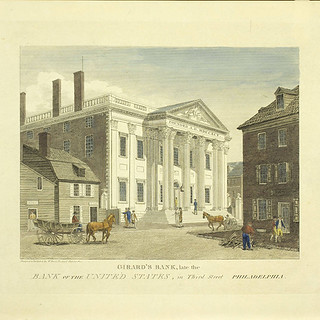 "Washington had a decision to make. Dare he veto a bill of such importance passed by both houses of Congress and eagerly submitted by his closest economic advisor? Dare he sign the
measure and face the accusation that he had passed a law that was, according to many prominent Virginians, impolitic, poor policy, and, perhaps most damning, clearly unconstitutional? Washington
showed Hamilton the arguments against the Bank set forth by Randolph and Jefferson and gave him a week to respond. In essence, he placed in Hamilton's hands the power to save his creation.
"Washington had a decision to make. Dare he veto a bill of such importance passed by both houses of Congress and eagerly submitted by his closest economic advisor? Dare he sign the
measure and face the accusation that he had passed a law that was, according to many prominent Virginians, impolitic, poor policy, and, perhaps most damning, clearly unconstitutional? Washington
showed Hamilton the arguments against the Bank set forth by Randolph and Jefferson and gave him a week to respond. In essence, he placed in Hamilton's hands the power to save his creation.
To read the complete article, see:
THE IMPLIED POWERS OF THE CONSTITUTION -- 3/23/17 (http://delanceyplace.com/view-archives.php?p=3296)
NEWMAN PORTAL DIGITIZES EDGAR ADAMS DOCUMENTS

Newman Portal user Saul Teichman recently loaned a group of Edgar H. Adams fixed price lists, as well as his 1911 auction sale catalog presenting duplicates from the William H. Woodin collection. Woodin, later Treasury Secretary under Franklin Roosevelt, famously traded two $50 gold patterns (J-1546, J-1548) to the Mint Cabinet in 1910 in return for “several crates.”
The inventory of these crates is something of a holy grail among pattern collectors, and it is unknown if such an inventory ever even existed. The 1911 auction catalog offers a hint as to what Woodin got from the Mint in return for the pair of gold patterns, which today are proudly on display in the Smithsonian as part of the National Numismatic Collection.
Edgar H. Adams Fixed Price Lists on Newman Portal:
https://nnp.wustl.edu/library/publisherdetail/517497
Edgar H. Adams Auction Catalog on Newman Portal:
https://nnp.wustl.edu/library/auctioncompanydetail/510207
The Newman Portal will host a user forum at the Central States show, Thursday, April 27, at the Renaissance Convention Center. This event will be held from 11AM – 1PM in the Serendipity Room. Lunch is included. We will present current status of the Newman Portal, including upcoming features and new content, and solicit user feedback on future direction. Admission is free, but please reserve a spot via email to Len Augsburger, Newman Portal Project Coordinator, at leonard.augsburger@wustl.edu. A similar event at Baltimore in November filled quickly, so please let us know as soon as possible if you wish to attend.
To visit the Newman Numismatic Portal, see:
www.newmanportal.org
To read the earlier E-Sylum article, see:
NEWMAN PORTAL USER FORUM AT CSNS CONVENTION (www.coinbooks.org/v20/esylum_v20n10a08.html)


NUMISMATISTS WHO WERE ALSO PAINTERS

Pete adds:
The Lapa painting is currently on eBay for a "Buy it Now" price of $1000. It is identified as a copy of "The Golden Sunset" by John Keys.
Ken Bressett writes:
There is a very famous author who was very modest about his skill as a trained commercial artist. His name was Richard Yeo, although he was better known to most as R. S. Yeoman. Attached is a shot of one of his paintings that proudly hangs in my home. It was done while he was in retirement in Arizona sometime around 1986.

To read the earlier E-Sylum article, see:
NOTES FROM E-SYLUM READERS: MARCH 19, 2017 : Quiz: Who Is The Numismatist Who Painted This Landscape?
(www.coinbooks.org/v20/esylum_v20n12a08.html)

HARVEY STACK RECALLS THE PHILIP SHOWERS SALE
 This week's E-Sylum by listing the publication by the Newman Portals of the Philip Showers collection was a great bid of news for you to publish, but you provided a prize for all
your readers and subscribers. A GIFT THAT WILL BE HARD TO DUPLICATE.
This week's E-Sylum by listing the publication by the Newman Portals of the Philip Showers collection was a great bid of news for you to publish, but you provided a prize for all
your readers and subscribers. A GIFT THAT WILL BE HARD TO DUPLICATE.
With the fact that you could publish the contents of an edition which had but 12 copies made, and using the fine photography we had in the book, and the super technology of the Newman Portal when you reproduced it for YOUR READERS you provided a record and information, referred to through the years but rarely seen in total.
Since Stack's was the ones who produced the book, and distributed at the time to a few places, I feel I could add to your subscribers and supporters some additional information about the happening. The following is how remember Philip Showers and his Half cents.
I first met Philip Showers in our offices in New York about the time I became a Full Time Numismatist in 1947. Phil was a very close friend of my father's as well as an obvious good client. "COPPER FEVER" reigned as a study area by a group of sophisticated collectors who used the shop we had as a CLUB HOUSE.
My father, was instilled with the early American Coins for their attractiveness as well as their importance to numismatics. Besides serving this elite group by locating and selling to them many of the prize copper coins that cane to the market in the post World War II years, he would join the group of the "Copper Nuts" as they often called themselves and would spend hours talking about, showing examples to be discussed, and the closeness of this group made learning about early copper coins a pleasure for me. Quite often when then met they invited me into to group and showed me what they themselves were learning and appreciating.
Among the group was Philip Showers, W.C. Blaisdel, Harold Bareford, Ray Gallo, Joseph Brobston, Joseph Spray, Dr. William Sheldon, (who liked Large cents in preference to the smaller Half Cents) , C. Douglas Smith, to mention but a few.
Philip Showers had the desire to put together the best quality collection he could amass. He traded as well as bought from the group who were not as advanced as he. He loved Copper, how well most were struck, how they had a lovely light toning which shown below the surface, and to him it was a miracle that they could strike coins in our early history without major machines of the 20th Century.
Phil Straus, who had appreciated the dedication that my father, Morton Stack, gave to him as he was building his collection promised him that when the day came that he wanted to pass on the collection to the next collector that Stack's would be given the opportunity to do it for him.
Phil came to the decision in the mid 1960's to sell he collection. BUT INSTEAD OF SELLING IT IN AN AUCTION CATALOG, he wanted it to be sold intact. The only provision he required was to have a book published, which would memorialize his efforts. But he knew that this would be costly so he said that we could produce a limited number of descriptive books as long as his collection would be recorded.
My father undertook the project. First of all since all the varieties were already listed in several reference books, to redescribe all the varieties was not necessary. A list would appear in the early part pf the book.
 But the quality of the collection, its overall beauty, if done correctly should be Photographed on plates for easy comparison with other coins of similar varieties. Where in the 1960"s
could we get a skilled photographer to do this work for us. Here again, the friendship and warm relations we had with our clients permitted us to approach someone who had the equipment and SKILL to
do the job. One of our clients and warm friend was a gentleman named Sam Andre. He was the lead photographer at a magazine at the time called PIC.
But the quality of the collection, its overall beauty, if done correctly should be Photographed on plates for easy comparison with other coins of similar varieties. Where in the 1960"s
could we get a skilled photographer to do this work for us. Here again, the friendship and warm relations we had with our clients permitted us to approach someone who had the equipment and SKILL to
do the job. One of our clients and warm friend was a gentleman named Sam Andre. He was the lead photographer at a magazine at the time called PIC.
Sam Andre won many national rewards for his work, and was a lover of coins and admired the Philip Showers collection. He looked at it with an eye of a Collector, and saw the life that good images can bring to those who appreciated Numismatics. Sam agreed to take the job, and spent many a weekend in our shop taking the pictures. He built a tent about the coins being photographed to diffuse the glare from photo lamps, he used minature spot lights to highlight the surfaces and design of each coin. He was like an artist creating a masterpiece with his photos.
After photographing the coins, he worked in his dark room to produce a set of photos of the entire Philip Showers Half Cent Collection. When he brought the photographic prints to us we had rarely seen a group of coins, no less a Collection, done in such detail. He said that he was in a way happy to say he would produce a dozen sets of the photographs, which he would mount on Hard Board so they could be bound in a book. That's what he did, and that's what the job we did to please Philip Showers, which was to him, and those who he wished the book given to, have a Photographic Record, expertly done as a fitting Memorial to his collection.
When we were offering the collection to those who might be interested in buying the coins, the book acted as our primary salesman. It was later sold intact to Willis Dupont. The rest of the history of the collection is already known.
The collection was broken up after it left the Dupont hands but the book still survives and records the importance of the collection, the work, effort, time and dedication of how I came to learn about the series, as I did with others whom Stack's served through the generations, and that all who would see how a dealer, abiding by the wishes of the collector, created a book that memorializes one of the great collections of Half Cents ever assembled.
I must say after reviewing the illustrations on line, with the equipment that we have available today, one could take the illustrations you reproduced and use it as a guide.
I am indeed proud to see this in print and thank you on behalf of the collectors who collect Half Cents, who did not know of this book, or did not have access to it, can now, either from the Newman Portal or The E-Sylum have guidance for their collection.
Thank you again for providing this information to Numismatics.
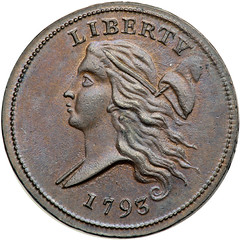

I reached out to Len Augsburger for help locating images of an individual Showers coin. He writes:
There are images in the Goldberg / Missouri Cabinet catalog (2014, Goldberg sale #77), which contained Showers pieces that landed in the Tettenhorst collection. I’ve attached one of these (1793 Cohen-4 half cent).
To read the earlier E-Sylum article, see:
NEWMAN PORTAL SCANS SHOWERS CATALOG (www.coinbooks.org/v20/esylum_v20n12a06.html)
NOTES FROM E-SYLUM READERS: MARCH 26, 2017
Stone Mountain Association Scrapbook Sought


Jim Harris writes:
Can anyone direct me to a copy or information relating to: ‘Mrs. N. Burton Bass’s ‘Scrapbook of the [Stone Mountain Association] Harvest Campaign’, “from the Harry Sponseller collection”? Unfortunate I have no other information. I assume from the subject, it was put together C. 1927, perhaps privately printed and in limited edition. Not even sure of the format. Any assistance would be appreciated.
Researcher Seeks Earliest Records of Washington Tokens
Regarding the Washington tokens mentioned in the Oxford Numismatic Society blog article last week, Bob Leonard writes:
The author of this blog thought that the Double Head cent was struck as late as the 1840s, because "the token was still in circulation at mid century." This is an inadequate reason: 18th-century New Jersey coppers ("horseheads") were still found as late as the 1850s.
The date of striking is uncertain, however. I have been trying to locate the earliest record of each piece in this series, and the best I can come up with is a mention in the Third Bulletin of the Proceedings of the National Institute for the Promotion of Science that Item No. 319, "Copper Cent of America, Washington and Independence, 1783" was donated to this forerunner of the Smithsonian Institution Nov. 13, 1843 by Capt. J. S. Inglee (Vladimir Clain-Stefanelli, History of the National Numismatic Collections, 1968, p. 75). Capt. Inglee clearly thought it was old, so a date in the 1820s is more likely.
Does anyone know of any earlier records for any of these four pieces?
To read the earlier E-Sylum article, see:
OXFORD SOCIETY DISPLAYS AMERICAN COINS (www.coinbooks.org/v20/esylum_v20n12a17.html)
On 'Dropping a Dime'
Jeff Starck of Coin World writes:
It refers to that time long ago when there pay phones (What are those?!) and it cost a dime to make a phone call, generally to avoid trouble.
Pete Mosiondz, Jr. writes:
It was my understanding as a kid that it meant that one would go to the corner pay phone and call someone to let somebody know of another person’s behavior or conduct, or perhaps calling the police. Pay phones were a dime back then for the first three minutes. You would drop the dime in the appropriate slot and dial the number. Pay phones, as I recall, had slots for nickels, dimes and quarters.
Well, if you Google the exact phrase (i.e. with the double quotes), the first hit on offer states:
The phrase refers to making a phone call. In early detective novels, it's a fairly literal reference to someone "dropping a dime" into a payphone slot to make a call (typically, to the police to rat out or snitch on some criminal activity).
Also on offer is this:
“Dimes” in Basketball. The term “dropping dimes” means making assists in basketball, and it is believed to refer to a person that could “drop a dime” into a payphone to tell the police about a crime. That means he “assists” the police in solving a crime.
Reading the above a couple of times should make it clear - and this comment is from a "Limey"!
P.S. I remember when (in the UK) one had to insert 3 pennies (value about 5c) into the slot, then either press Button A to get connected or Button B to get the money back. (Must have been about the mid 1950s.)
To read the earlier E-Sylum article, see:
VIDEO: THE 1913 LIBERTY HEAD NICKEL (www.coinbooks.org/v20/esylum_v20n12a14.html)
Dave Hirt On Maximilian Salmon, Lyman Low and George Lovett
Dave Hirt writes:
The bio on Maximilian Salmon was interesting to me. I own catalogs of both his coin sales. His address in the catalogs is 137 Pa. Ave. Baltimore, Baltimore. The same address is also listed in a copy of Mercer's Numismatic Directory for 1884 that I have.
Also, I was looking through the catalog of Lyman Low's sale of May 31, 1922, and noticed a lot that I will quote his description:
1887 Seneca Falls, NY 100th ann. Early view of the falls and log cabin. Dies by G. H. Lovett, who paid compliment by placing L H. L. NY in dies, the only instance where the cataloger name appears on a medal or token.
I wonder what was the connection of Lyman Low and Seneca Falls?
To read the earlier E-Sylum article, see:
MAXIMILIAN SALMON (1857-1925) (www.coinbooks.org/v20/esylum_v20n11a12.html)
Albert Delmonte
Jeffrey Zarit writes:
The story of the Dutch Ducat was very interesting, however, the Delmonte book was written by ALBERT Delmonte and NOT ANDRE. I believe there was a supplement for the gold version as there was for the silver one, with corrections and more plates
. In the mid 1970's, I met Mr. Delmonte when he came to the New York International convention. He was very knowledgable and I wish that I had more knowledge about Dutch numismatics then. Today, I would have dozens of detailed questions to ask him.
I believe the Dutch coins from about 1500-1800 are just as interesting and just as complex as the Germanic ones, however, they do not get the notice that they deserve.
To read the earlier E-Sylum article, see:
PRIMARY RESEARCH AND THE NETHERLANDS DUCAT (www.coinbooks.org/v20/esylum_v20n12a26.html)
On Bar Mitzvah Medals
Jeff Starck writes:
 These are cataloged in Israels’ Money & Medals 1948/1973, published by Arnold Kagan. The work is indispensable for these early Israeli medals, with design and production details to
answer almost any question.
These are cataloged in Israels’ Money & Medals 1948/1973, published by Arnold Kagan. The work is indispensable for these early Israeli medals, with design and production details to
answer almost any question.
I stumbled upon a few large bronze examples of this medal in my flea market and antique shop hunting, and noted Judaica expert/auctioneer William Rosenblum has sold examples from time to time. A total of 12 examples of various sizes and an array of metals were made, with mintages as high as 40,000 for the 19mm, 5-gram gold version.
The medal was issued to mark the Israeli states’ 13th anniversary or “birthday” but the importance of the Bar Mitvah design and the ubiquity of the more affordable bronze and silver examples makes them appropriate and popular gifts for that important ceremony in Jewish life.
I should also state that the medals are found on eBay from time to time, as this example is among my recent listings:
Jewish Bar Mitzvah bronze medal tribes of Israel, 59mm (www.ebay.com/itm/112310351461)
Bill Rosenblum writes:
The first issue of the medals was issued in 1961 on the 13th anniversary of Israel. Various size medals in gold, bronze and silver were issued then. The 1961 gold medals had mintage's of 10,000 for 27mm, 20,000 for the 22mm and 40,000 for the 19mm. They are not scarce but are always very popular and I've sold them to people who wanted an unusual Bar Mitzvah gift. And Rita and I have probably given out more than we've sold as our Bar Mitzvah gift. Similar issues were also struck in 1971, 1978 and the early part of this century.
The first issues were also struck in 19, 35 and 59mm in silver and 59mm in bronze. And there are number of varieties of some of those that make an interesting challenge to some. Some of the 19mm silver pieces were also issued as a key chain. Back in the 1970s there was even a dealer in Southern California who basically made a market (perhaps a small one) by buying and selling Bar Mitzvah medals.
To read the earlier E-Sylum article, see:
NUMISMATIC NUGGETS: MARCH 19, 2017 : Bar Mitzvah Gold Medal (www.coinbooks.org/v20/esylum_v20n12a21.html)
More On Death By Books
Larry Gaye writes:
Bibliomortis is my candidate for "Death By Books" or bookshelves. I hope I'm one of the first, not to die by books, but to contribute my thoughts and insight regarding the subject.
Morten Eske Mortensen of Copenhagen writes:
In the year 2013 I actually by a split margin of just 1 minute survived the horrific destiny of ”Death by numismatic bookshelves”.
A series of photographs of this sad event have been put on the web. The photos show the exact place (the working desk), where I would have been either crushed or squeezed or fixated (for starvation) to death by hundreds and hundreds of kilograms of coin books pressing down on my back fixating my chest against the working place desk.
Today the shelves have been solidly bolted to the wall !

To view Morten's photos, see:
http://numisbooks.dk/info/Reolvaeltning201303.htm
To read the earlier E-Sylum article, see:
MORE ON THE THREAT OF COLLAPSING BOOKSHELVES (www.coinbooks.org/v20/esylum_v20n11a07.html)

VOCABULARY TERM: INTERRUPTED REEDING

The inner aperture of this coining collar shows a blank area between areas where reeding has been machined into the collar wall. This creates the edge of a struck piece using this collar in a coining press. It will have a plane edge where the blank area without reeding is located and two areas with. Note lettering on the collar indicates this is for a 50mm (2-inch ) coin, dual blank areas – called “bars” here -- and the date it was made. Any number of blank with reeded areas is called interrupted reeding. Photo Medallic Art Company.
 Interrupted Reeding. Struck from a collar with one or more smooth areas on the inner wall of the collar alternating with the reeding. This is in contrast to a
piece which is fully reeded forming a REEDED EDGE, or completely smooth forming a PLANE EDGE. When only one smooth area is formed, this is generally at the bottom or top edge so edge marking can be
placed there at some later time. See REEDING, EDGE LETTERING AND NUMBERING.
Interrupted Reeding. Struck from a collar with one or more smooth areas on the inner wall of the collar alternating with the reeding. This is in contrast to a
piece which is fully reeded forming a REEDED EDGE, or completely smooth forming a PLANE EDGE. When only one smooth area is formed, this is generally at the bottom or top edge so edge marking can be
placed there at some later time. See REEDING, EDGE LETTERING AND NUMBERING.
In 1965 the Franklin Mint developed a method of interrupted reeding that provided gambling tokens of similar diameter with edge distinctions to identify different casino's tokens by the edges
when stacked in columns or laid out in rows. Pairs of blank and reeded areas, plus different width of reeds give this distinction. A separate collar with unique blank and reeded areas provided this
when pieces were struck in this collar. It was granted patent number 3350802 in 1967 for this type of reeding. See REEDED EDGE.
CLASS 10.2

LAST CALL
Two Weeks Left! If you want a copy of this incredible book order now at the discounted price of $50. Price goes up to original price of $100 on April 15 if any copies are still available.Order all three of my books and a new book from Spain.
Encyclopedia of Coin and Medal Technology
1,854 entries on every aspect of how coins and medals are made, cataloged and collected., Sample entries in recent E-Sylum issues as Vocabulary Words. Do not miss this opportunity! 678 pages, card cover. . . . .$50
Monograms of American Coin and Medal
Artists. Identifies over 450 initials and monograms found on American coins and medals. 147 pages, card cover. . .. . . $45
Who’s Who Among American Medallists.
Biographies of 4,137 artists of American coins and medals, with some as long as 4 pages. With article of American Art Styles, bibliography 386 pages, Hard cover. . … $65
Just published! El Numiscadero, English to Spanish and Spanish to English. By Gary Beals. I served as technical editor for this innovative work. Useful for all Spanish numismatics. Fully illustrated. Over 2,000 terms. 354 pages Card cover...$35
Dick Johnson 139 Thompson Drive Torrington, CT 06790
WAYTE RAYMOND (1886-1956)
 Wayte Raymond (1886-1956), was born at Norwalk, Fairfield County, Connecticut on November 9, 1886, son of Wayte A. Raymond (1852-1934), a brush manufacturer, traveling salesman, and a
native of Battle Creek, Michigan, and Harriet W. Raymond (1849-), a native of Connecticut. His Prescott ancestry served in the Revolutionary War.
Wayte Raymond (1886-1956), was born at Norwalk, Fairfield County, Connecticut on November 9, 1886, son of Wayte A. Raymond (1852-1934), a brush manufacturer, traveling salesman, and a
native of Battle Creek, Michigan, and Harriet W. Raymond (1849-), a native of Connecticut. His Prescott ancestry served in the Revolutionary War.
Wayte Raymond, the gentle giant of American Numismatics on whose broad shoulders we are borne aloft.
Wayte Raymond was a prolific writer and publisher, one of the great innovators in American numismatic history introducing Beistle's patented new coin storage boards with their clear transparent protective viewing windows he began manufacturing them under his own brand name : National Coin Albums, and also introduced photographically illustrated standard coin catalogues, a wide variety of numismatic literature on American and foreign coins, tokens, and medals, and sixty-nine coin auction sales under the name Wayte Raymond, forty-three coin auction sales under the name United States Coin Company, and fifty-four coin auction sales under the name J. C. Morgenthau, totaling 166 known coin auction sales. Among his innovations was streamlining or so-called modernizing of American numismatics making it exclusive to coins, medals, tokens, paper money, and its storage materials and literature. In 1957, John J. Ford dubbed him "The Dean of American Numismatists".
From 1901 to 1912, he worked as a teller at the City National Bank, South Norwalk, Connecticut, and while handling old coins and paper money he became interested in them. In May 1902, at the age of 15 1/2 he applied to the ANA.
On June 1, 1902, he became ANA Member No. 396. He also became a member of the ANS.
He began selling English silver pennies of Edward I and II, London and Canterbury Mints, at 50 Cents apiece, in The Numismatist, August 1902 issue on page 250.
In the May 1903 issue of The Numismatist, he solicited buying U. S. Half Cents and Hard Times Tokens. In the June issue he expanded his want list to include pre-1820 EAC, English copper from James I - William IV, and British colonials.
In 1904, he began to publish his Fixed Price Lists and solicited customers in the May issue of The Numismatist.
During the period from 1904 to 1908 he began amassing coins from collectors and over the counter at the bank organizing them and selling them through lists now lost.
In 1908, he was a charter member of the New York Numismatic Club.
On his 22nd birthday, November 9, 1908, he held his first mail bid coin auction sale.


United States Coin Company
In September 1912, he quit working as a teller at the City National Bank, South Norwalk, Connecticut, established the United States Coin Company, becoming a full-time coin dealer at 200m Fifth
Avenue, New York, with partner Elmer Sears of Swansea as the treasurer. From 1912 to 1918 they held 43 coin auction sales.
In May 1915, he sold the Granberg/Woodin Collection.
In July 1915, Edgar Holmes Adams appears to have assisted Raymond publishing the United States Coin Company Bulletin.
From 1916 to 1933, he published the Coin and Medal Bulletin. (Clain Stefanelli 473) From April 1916 to March 1917 Edgar Holmes Adams co-edited Coin and Medal Bulletin with Wayte Raymond. Raymond revived the publication in a new series from 1924-1933.
When the new Mercury Head dime made its first appearance Wayte Raymond remarks were published in the December issue of The Numismatist,
"I think very favorably of the new dimes. The head of Liberty has considerable resemblance to some coins of the Roman Republic, and is very artistic. The only criticism I have to make is the fact that the words "In God We Trust" and the date seem to be placed on the die as an afterthought, as there is really no place for them on the obverse."
In 1917, he was made a Fellow of the American Numismatic Society.
On April 25, 1917, he married Olga Eleanor Louise Osterholm (1887-1976), of Brooklyn, New York.
On May 1, 1918 the United States Coin Company was liquidated.
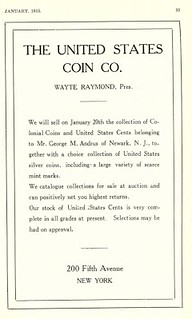
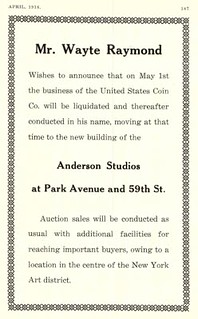
Anderson Studios / Scott Stamp & Coin Company Wayte Raymond's public announcement of the dissolution of the United States Coin Company published in the April 1918 issue of The Numismatist, page 137. He moved to the Anderson Studios, Park Avenue and 59th Street,
In 1920, he published with Edgar Holmes Adams a book on the history of American merchant’s store cards and checks entitled : United States Store Cards: A List of Merchants’ Advertising, Checks, Restaurant Checks and Kindred Pieces Issued from 1789 up to Recent Years (New York : E. H. Adams & W. Raymond, 1920).
On July 15, 1922, he and his wife Olga sailed aboard the S. S. Olympic to the British Isles and to France.
In March 1923, he handled the purchase of the Col. James W. Ellsworth 2,000 specimen collection for $100,000, the largest amount ever paid in the annals of American numismatic history at that time. He already was friends with Col. Green who became his most important client until Green's demise in 1936.
In 1931, he published Private Gold Coins Struck in the United States, 1830-1861; and United States Copper Coins.
In 1932, he began to publish his annual series : Standard Catalogue of United States Silver and Copper Coins.
From 1932 to 1945 he catalogued together with Philadelphia coin dealer James MacAllister and conducted auction sales for J. C. Morgenthau Galleries, known as the Raymond-MacAllister, Morgenthau Sales.
In 1933, he published United States Notes 1861-1923; and Silver Coins of the United States Mints; and Premium Values of Rare United States Coins ; and Standard Catalogue of Early American Coins 1652-1796.
From 1934 to 1946 he managed the coin department for Scott Stamp & Coin Company, ending his term he handed the baton to his former employee John J. Ford and his company, New Netherlands Coin Company.
To read the complete article, see:
RAYMOND, WAYTE
(https://sites.google.com/a/numismaticmall.com/www/numismaticmall-com/raymond-wayte-a)

U.S. MINT PRINCIPAL DEPUTY DIRECTOR RHETT JEPPSON
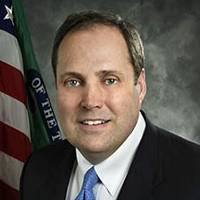 From January 12, 2015, until the day of the inauguration of Donald Trump, Matthew Rhett Jeppson ran the U.S. Mint, despite the Senate’s failure to act on his nomination as Mint director.
Located in the Treasury Department, the Mint is responsible for minting U.S. coins (but not printing currency). The Mint director’s post has been vacant since January 2011, when Edmund Moy left.
Although President Barack Obama nominated auto executive Bibiana Boerio to the job in 2012, her nomination died in committee. Jeppson himself was nominated to be Mint director in July 2015 and made
it as far as a hearing before the Senate Committee on Banking, Housing and Urban Affairs eight months later, but he was never confirmed, despite being a lifelong Republican.
From January 12, 2015, until the day of the inauguration of Donald Trump, Matthew Rhett Jeppson ran the U.S. Mint, despite the Senate’s failure to act on his nomination as Mint director.
Located in the Treasury Department, the Mint is responsible for minting U.S. coins (but not printing currency). The Mint director’s post has been vacant since January 2011, when Edmund Moy left.
Although President Barack Obama nominated auto executive Bibiana Boerio to the job in 2012, her nomination died in committee. Jeppson himself was nominated to be Mint director in July 2015 and made
it as far as a hearing before the Senate Committee on Banking, Housing and Urban Affairs eight months later, but he was never confirmed, despite being a lifelong Republican.
Born in Midvale, Utah, circa 1965 to E. Mark and Orma Jean Jeppson, Matthew Rhett Jeppson was the only boy out of four children. After the family moved to Florida when Rhett was 16, he earned a B.A. in History at the University of Florida in 1987.
Jeppson joined the Marine Corps in 1988, where he served as principal battalion staff officer, 81mm Mortar Platoon commander, Rifle Company executive officer, and Rifle Platoon commander in the 1st Marine Division from 1989 to 1991. During the 1990 Gulf War, he led Marines into combat in Kuwait.
Jeppson had to take a step back from the Corps from 1992 to 1994, in order to run his father’s small construction business during a serious illness.
Returning to duty, Jeppson served as operations and exercise officer at Special Operations Command Central from 1995 to 1999.
Jeppson also worked for the State of Florida. He was director of state purchasing and special assistant to the secretary at the Department of Business and Professional Regulation of the State of Florida from 1999 to 2003.
Jeppson’s later Marine Corp service included stints as counter-terrorism planner and chief of current operations for Marine Forces Europe from 2001 to 2003; chief of joint national training capability and European engagements lead at the United States Special Operations Command from 2004 to 2008; deputy director of operations for U.S. Forces Afghanistan from 2009 to 2010; and lead crisis response planner at U.S. European Command from 2010 to 2012. In January 2016, Jeppson retired from the Marine Corps with nearly 28 years active and reserve service.
Jeppson joined the Small Business Administration (SBA) in 2012, serving as associate administrator in the Office of Veterans Business Development from 2012 to 2015, and as acting chief operating officer from 2014 to 2015.
Starting in January 2015, he served in the newly created position of principal deputy director of the Mint.
Rhett Jeppson is married to Renee Jeppson, with whom he has four children: Holly, Heidi, Hayden, and Hans.
To read the complete article, see:
Principal Deputy Director of the United States Mint: Who
Is Rhett Jeppson? (www.allgov.com/news/top-stories/principal-deputy-director-of-the-united-states-mint-who-is-rhett-jeppson-170323?news=860124)
RESEARCHING SS CENTRAL AMERICA'S CARGO
A Coin Talk discussion thread was started this week when member TypeCoin971793 mentioned buying a an October 17, 1857 newspaper featuring a contemporary account of the sinking of the SS Central America, the shipwreck which ultimately yielded a trove of gold-rush era ingots and coins.
Member doug444 responded with his recollection of meeting and working with Tommy Thompson, the leader of the team which recovered the treasure with underwater robot technology. -Editor
 As you may recall, Tommy Thompson worked at Battelle Labs in Columbus, Ohio. I was a Columbus Realtor, working for Donahue Realtors, now defunct. I was his Realtor at the time he was
finishing up the deep-water technology. He and his wife and two darling little boys lived in a big old house on Neil Avenue just south of the OSU campus, where he had a short bike ride to work.
As you may recall, Tommy Thompson worked at Battelle Labs in Columbus, Ohio. I was a Columbus Realtor, working for Donahue Realtors, now defunct. I was his Realtor at the time he was
finishing up the deep-water technology. He and his wife and two darling little boys lived in a big old house on Neil Avenue just south of the OSU campus, where he had a short bike ride to work.
They had bought a small grocery to serve residents of that area, known as Victorian Village, but the store was losing money, so I listed the property for sale, including inventory. No takers. In the meantime, Tommy found out I knew coins pretty well, and hired me to secure San Francisco mint records of the 1850s to try to make an educated guess about what he might find.
Eventually, I predicted he would find lots of San Francisco half eagles and double eagles of the 1850s, although neither denomination was struck until two years before the wreck, thus limiting the variety of dates significantly. I also predicted there would be some private and territorial gold, mostly Moffat. This proved to be correct.
By that time, we had become good friends, much more than Realtor and client. I asked to invest in the venture, but he refused, stating that it was too risky for someone with such a small, intermittent, unreliable income (Realtors, he meant).
In June, 1988, I moved from Columbus to Jacksonville, Florida, and never saw him again, although an eerie thing happened; my first day in Jacksonville, the newspaper published a front page story about him, speculating that his vessel might actually be operating out of the Jacksonville area, instead of Charleston SC, as widely-believed. A large photo showed a $20 gold piece laying on clean white sand on the bottom of the ocean.
When I first met him 30+ years ago, he was a smart, personable, likable guy with a big dream. His boys would be about 40 now.
To read the complete article, see:
A contemporary account of the SS Central America Disaster
(www.cointalk.com/threads/a-contemporary-account-of-the-ss-central-america-disaster.293365/)

THE NEW ENGLAND GOLD HOAX OF 1898
According to the National Ocean Service, our oceans hold some 20 million pounds of gold, suspended in normal seawater. But this gold is spread throughout the normal mineral content of seawater to the tune of “parts per trillion.” As the NOAA puts it, “Each liter of seawater contains, on average, about 13 billionths of a gram of gold.” There are also gold deposits within the seafloor, but profitably mining them is far beyond our current abilities.
Nonetheless, gold is gold, and it has a way of making people believe all sorts of speculative things. Ever since British chemist Edward Sonstadt discovered that there was gold in seawater in 1872, there have been those who have tried to capitalize on it, honestly or not.
The earliest, and largest, attempt to mine the oceans for gold took place in the 1890s. And it was all a hoax. The scam began when New England pastor Prescott Ford Jernegan claimed to have invented a “Gold Accumulator” that could suck gold from seawater via a process involving specially treated mercury and electricity.
Claiming that the inspiration for the contraption had come to him in a heaven-sent fever dream, Jernegan, along with childhood friend Charles Fisher, started the Electrolytic Marine Salts Company. Jernegan performed a seemingly successful demonstration of the accumulator to some potential investors, and they were off and running. An attractive prospectus was drawn up that claimed there was “enough gold in the waters of Long Island Sound to pay off the National Debt and leave a larger gold reserve in the Treasury than the Government has yet possessed.” According to the New England Historical Society, by 1898, Electrolytic Marine Salts had garnered around $1 million in investor cash.
The company opened a gold-extraction plant in remote Lubec, Maine, where their operations would be less likely to be inspected. The operation was to use 1,000 of the accumulators to drag the waters for gold. Excitement about the operation became such that work on a second, larger plant began, with the hopes that Lubec might be turned into a gold-rush boom town.
However, in July of 1898, things fell apart. As the shareholders began wanting a closer look at their investment, both Jernegan and Fisher disappeared. According to The New York Times, Jernegen had recently taken out $80,000 in government bonds. It would come out that during the initial demonstration, Fisher had swum down to the accumulator and replaced the pure mercury with his own gold-laced mixture. The accumulators turned out to be little more than trumped-up soup kettles.
When the hoax was exposed, hundreds who had come to Lubec for work were instantly unemployed, the plant was shut down, and the investors were out of their money. Jernegan fled to Europe with his family, and managed to weasel his way out of jail time, while Fisher was simply never heard from again.
To read the complete article, see:
(www.atlasobscura.com/articles/gold-ocean-sea-hoax-science-water-boom-rush-treasure)
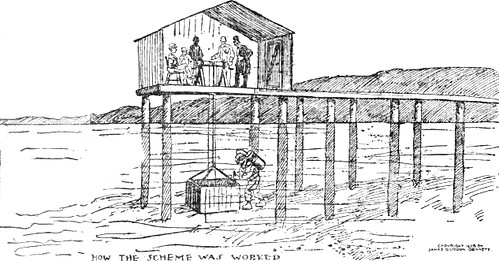
With offices opening quickly in New York, London and Boston, the Electrolytic Marine Salts Company announced its plans to the world. The papers were quick to spread the news that the company was accepting investors and that it would soon harvest tons of gold from the sea.
 The company created elaborate prospectuses to entice investors, and Jernegan relentlessly pursued investors among his former schoolmates and acquaintances.
The company created elaborate prospectuses to entice investors, and Jernegan relentlessly pursued investors among his former schoolmates and acquaintances.
The money poured in, mostly from Massachusetts, Connecticut and New York. The company now had to set up shop and start operations. Looking for a place that would avoid prying eyes, they settled on Lubec, Maine. Its extremely high tides and strong currents, they explained, made it the perfect location. There, they leased a grist mill, constructed a series of underwater “accumulators” to harvest the gold, and employed more than 100 men.
In Lubec, Fisher simply repeated his act, slipping under the water and salting the accumulators with gold to be brought to the surface, analyzed and shipped to the company’s offices in Boston. As the gold continued to come in to Boston, the word spread and more investors were induced to buy shares.
New England Gold Hoax of 1898: Greed Meets Moxie . (www.newenglandhistoricalsociety.com/new-england-gold-hoax-1898/)
THE BOOK BAZARRE
POGUE V SALE AT EVERGREEN THIS WEEK

The panorama of American numismatics has many landmarks. One of the first was the establishment of the Mint Cabinet in July 1838—setting the foundation for what is the core of the National Numismatic Collection at the Smithsonian Institution today. Similarly, the founding of the American Numismatic Society in 1858 and of the American Numismatic Association in 1891 will be forever remembered. Some of our readers were part of the November 1962 Treasury release of the exceedingly rare (up to that point) 1903-O dollar. And then there was the discovery and marketing of the unequalled treasure of American gold ingots and coins from the treasure of the S.S. Central America.
In the field of great collections and their sale, the 19th century had its own landmark events—the Bushnell Sale in 1882, the Parmelee Sale in 1890, and others. Similarly, a number of great collections crossed the auction block in the early 20th century.
This brings us to relatively modern times when quite a few great collections have been cataloged and sold, with Stack's Bowers Galleries and its antecedents handling more than all other auction firms combined. A short list includes the Garrett Collection for the Johns Hopkins University, the Amon Carter, Jr. Family Collection, the Norweb Collection, selections from the Virgil M. Brand Collection, the unique Louis E. Eliasberg Collection, the Harry W. Bass, Jr. Collection, and the John J. Ford, Jr. Collection.
Then, starting in 2015 came our offering of the greatest collection ever formed in terms of high quality, rarity, and value. In four events we have showcased the D. Brent Pogue Collection Parts I to IV. Already, the total realization is greater than any rare coin collection sold anywhere in the world! Part V, to be held on Friday evening, March 31, in conjunction with Sotheby's, will be epochal as well.
The sale will be held at the Evergreen Museum & Library in Baltimore. Owned by and under the custodianship of the Johns Hopkins University, this is the ancestral home of the Garrett family, starting with T. Harrison Garrett, who began his interest in coins while a student at Princeton in 1864, A scion of the family that developed and controlled the Baltimore & Ohio Railroad, Garrett, in addition to his business activities, was a collector extraordinaire. In Evergreen House he had a complete set of autograph documents of the signers of the Declaration of Independence, a full double-elephant-folio set of John J. Audubon's Birds of America, and an incredible library. A special area connected to the library was set aside for his coin collection—which grew to become the finest in America in its time.
Our sale of the D. Brent Pogue Collection Part V will be extraordinary for the coins it contains and for the venue in which it will be held. Nothing like this has ever been done before.
You are invited to attend in person. Our staff will be at the Whitman Coin & Collectibles Expo at the Baltimore Convention Center on Thursday and Friday—a dynamic event in its own right. Our auction will include sessions of coins, tokens, medals, and paper money—including the Blue Moon Collection, a cabinet that has been off the market for more than a generation. A lively dealers' bourse will be a drawing card as well. Lot viewing for the Pogue Collection Sale V will be in a special area.
The staff of Stack's Bowers Galleries will be on hand to meet and greet you—the red carpet will be rolled out! Plan to be there!
To read the complete article, see:
Be a Part of History in the Making (http://www.stacksbowers.com/News/Pages/Blogs.aspx?ArticleID=2479)
To read earlier E-Sylum articles, see:
NEW BOOK: THE D. BRENT POGUE RARE COIN CABINET (www.coinbooks.org/esylum_v18n06a05.html)
KRALJEVICH ON POGUE COLLECTION, PART V (www.coinbooks.org/v20/esylum_v20n11a19.html)
SELECTIONS FROM THE POGUE COLLECTION, PART V (www.coinbooks.org/v20/esylum_v20n11a20.html)
THE POGUE FAMILY COLLECTION AND EPIC PAST SALES

Before citing auctions of other great collections, it is important to emphasize the scope and importance of the Pogue Collection, which is phenomenal in some ways while being limited in others. The Pogues did not build sets of all series of classic U.S coins. More than 90% of the coins in the five sales were dated before 1840. Before 2004, the Pogues were limiting their collection to pre-1840 U.S. coins, with but a few exceptions.
The focus on the period 1793-1839 period is consistent with a tradition that dictates that design types that started before 1837 and ended before 1840 are ‘early U.S. coins’.
The epic collections and corresponding great auctions of the past did not emphasis early U.S. series in this manner. They all included extensive runs of coins from later time periods. Even so, the amazing accomplishments of the Pogues and their advisors in the field of pre-1840 U.S. coins are worth emphasizing repeatedly. This core (1793-1839) Pogue Collection is incredibly cool and is meaningful to a wide range of coin collectors.
These great sales have been part of the culture of coin collecting in the U.S. ever since the 1850s. Rarities from the auctions of the McCoy Collection in 1864 and the Mickley Collection in 1867 are often discussed in the present.
It is relevant that books about Eliasberg, the Garrett Collection and are popular among collectors. John J. Pittman is a legend who is frequently discussed in the present, including repeated references to his approach to collecting. Published interviews with Pittman are themselves collected and studied.
 Here is a list of other great collections sold at public auction that are particularly relevant to the Pogue sales. The names of the auction firms are beside the point. The years during
which auctions were held are cited along with the last names of collectors. McCoy (1864), Mickley (1867), Parmelee (1890), Cleneay (1890), Stickney (1907), Earle (1912), Jenks (1921), Boyd (1944-45),
JAS (1975, ’89-90, ‘94-95), Norweb (1987-88), Eliasberg (1982, 1996-97), Pittman (1997-98) and Newman (2013-14).
Here is a list of other great collections sold at public auction that are particularly relevant to the Pogue sales. The names of the auction firms are beside the point. The years during
which auctions were held are cited along with the last names of collectors. McCoy (1864), Mickley (1867), Parmelee (1890), Cleneay (1890), Stickney (1907), Earle (1912), Jenks (1921), Boyd (1944-45),
JAS (1975, ’89-90, ‘94-95), Norweb (1987-88), Eliasberg (1982, 1996-97), Pittman (1997-98) and Newman (2013-14).
Among collections that have been publicly auctioned over the last 40 years, only one rivals the Pogue Collection in regard to U.S. coins dating from 1793 to 1839. This is the all-time greatest collection of classic U.S. coins overall, the Eliasberg Collection. A comparison of Eliasberg pre-1840 coins to Pogue coins would require a separate discussion. It is pertinent that there were a large number of Eliasberg pedigreed coins in the Pogue Collection.
To read the complete article, see:
The Marvelous Pogue Family Coin Collection, Part 22: Epic Sales in
the Same League (www.coinweek.com/auctions-news/the-marvelous-pogue-family-coin-collection-part-22-epic-sales-in-the-same-league/)
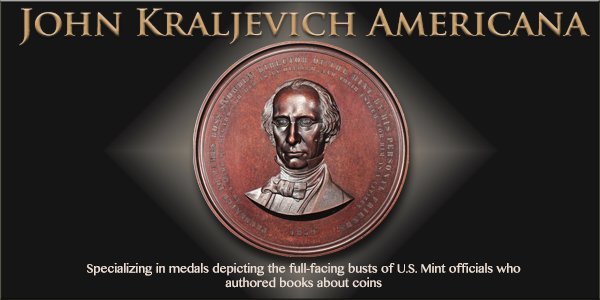
1795 DRAPED BUST DOLLAR SELLS FOR £28,000

A 1795 American silver dollar has been sold at a Suffolk auction house for a stunning £28,000.
Mr Sadler said: “Bidding for it was ferocious.
“It has gone to a good home in the UK, but I wouldn’t be surprised if it eventually went back to the USA.”
The Lockdales coins and collectables sale catalogue had a guide price of £5,000 to £8,000 against the rare dollar.
Bidding started at £10,000 and continued to rise.
To read the complete article, see:
Rare 220-year-old silver dollar sold at Martlesham auction for £28,000
(www.eadt.co.uk/news/rare_220_year_old_silver_dollar
_sold_at_martlesham_auction_for_28_000_1_4942139)
This silver dollar that recently sold at auction in London is an example of the 1795 B-14, BB-51 die marriage. Traditionally this Type was known as, “1795 Draped Bust Left.” Today the PCGS terms this the, “Off-center Bust” Type, and the Red Book calls it, “1795, Uncentered Bust.”
At first glance the photo of this 1795 Draped Bust, Small Eagle Dollar looks like a really nice coin. In particular the strike on the eagle’s breast feathers appears to be strong for the die marriage, as does Liberty’s hair. The color is slightly dark, but (from the photo) the coin looks like a 200+ year coin should. I can’t really tell much about the lustre from the photo, nor can I enlarge it and see the surface detail. From a details standpoint the coin seems to be AU58, with slight wear noted on the high points.
On the other hand, nothing pays off like having a trusted person look at an expensive coin for you. What I couldn’t see in the photo (per my European representative) is, “The coin has significant graffiti in the right obverse field, and minor graffiti on the upper reverse. The toning is "second generation", at best.”
This coin realized approximately $30,200 U.S. This is about what a (unimpaired) PCGS AU58 example might sell for at auction.
W. David Perkins
Centennial, CO
www.davidperkinsrarecoins.com/

SELECTIONS FROM THE SHAW & BETTENCOURT SALE
Lot 8: Libertas Americana Medal
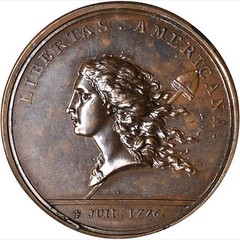

"1781" (1782) Libertas Americana Medal. Bronze. 47 mm. By Augustin Dupre. Betts-615. MS-62 BN (PCGS).
Only about 100 to 125 or so examples are known in bronze, and they vary in grade from well worn to Gem Mint State, with the present piece residing comfortably among the nicer specimens. There is perhaps no medal or coin that speaks so loudly about the birth of the United States of America than the Libertas Americana medal.
Designed by Augustin Dupre in Paris in 1782, this beautiful type was instigated by Benjamin Franklin, then minister to France and representative of the newly proclaimed United States of America. The most prominent feature for history buffs is the date below Liberty's bust on the obverse -- 4 Juil 1776. The head of Liberty facing left on this famous rarity with her cap on a pole inspired the earliest U.S. Mint engravers to make the liberty cap motif part of our nation's first coinage in 1793. Dupre's design is about as beautiful and intricate as a medal can be, especially on the reverse. The intricate interplay between the reverse features is laden with iconography. An infant Hercules representing the new American nation strangles two serpents that represent the British armies at Saratoga and Yorktown, the beginning and end of struggles during the Revolution. France, here depicted as Minerva, holds a shield above the infant and her spear keeps the British lion at bay; the lion's tail between its legs is a symbol of England's defeat. Dates in the exergue, October 17, 1777 and October 19, 1781, represent the dates of the American victories at Saratoga and Yorktown.
To read the complete lot description, see:
"1781" (1782) Libertas Americana Medal. Bronze. 47 mm. By Augustin Dupre. Betts-615.
(https://auctions.stacksbowers.com/lots/view/3-6Y0R9)
Lot 24: Charleston Company of Volunteers Medal


Undated (Circa 1848) Charleston Company of Volunteers Medal. Silver. 56 mm. 74.6 grams. By Charles Cushing Wright. About Uncirculated.
Obv: Liberty welcoming a returning ship. Legends include PRESENTED BY THE CITY OF CHARLESTON / TO THE CHARLESTON COMPANY OF VOLUNTEERS IN MEXICO. Rev: Soldier holding a flag and an upright sword standing atop the damaged Garita de Belen in Mexico City. Names of battles around VERA CRUZ CHURUBUSCO CHEPULTEPEC GARITA DE BELEN. An unnamed specimen without the usual mount -- and no evidence of one ever having been removed.
To read the complete lot description, see:
Undated (Circa 1848) Charleston Company of Volunteers Medal. Silver. 56 mm. 74.6 grams. By Charles Cushing Wright.
(https://auctions.stacksbowers.com/lots/view/3-6Y3LA)
Lot 50: Washington Manly Medal

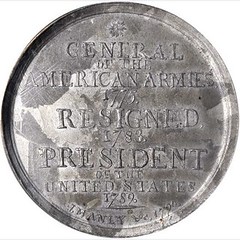
"1790" (Circa 1858) Washington Manly Medal. Second Obverse. White Metal. 48 mm. Engraved by Samuel Brooks, for James Manly. Baker-62A, Musante GW-11. MS-62 (NGC).
An especially rare variant of this historic medal. Utilizing the original reverse combined with an obverse very similar to the original, apparently by engraver Brooks' own hand, but with a varying inscription encircling Washington's bust. This type is inscribed GEO. WASHINGTON NATUS VIRGINIA, as contrasted to GEO. WASHINGTON BORN VIRGINIA as seen on the "originals." This type also includes the additional inscription BP WM. C. (Birthplace Westmorland County) which does not appear on the earlier type. Finally, the inscription S. B. F. / 11 FEB. O. S. / 1732 appears on the truncation and below the bust in place of a simple date as on the original type. Minor die crumbling is noted on the rim near 12 o'clock on the obverse, and a die crack extends from there to the top of Washington's head, progressing through the S in NATUS.
According to both the Rulau-Fuld and Musante Washingtoniana references, there are only two white metal impressions of Baker-62A known
To read the complete lot description, see:
"1790" (Circa 1858) Washington Manly Medal. Second Obverse. White Metal. 48 mm. Engraved by Samuel Brooks, for James Manly.
Baker-62A (https://auctions.stacksbowers.com/lots/view/3-6Y1T4)
Lot 67: 1861 U.S. Mint Oath of Allegiance Medal
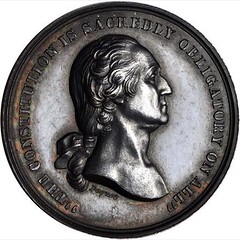

1861 U.S. Mint Oath of Allegiance Medal. Silver. 31 mm. 17.5 grams. Baker-279, Musante GW-476, Julian CM-2. Thick Planchet. About Uncirculated.
Deep steel gray on the obverse with golden highlights around the peripheries, the reverse in a similarly deep color, but with glorious electric blue, fuchsia and golden undertones in abundance. A lovely example of this historic Mint medal, struck in commemoration of the Mint's employees having taken an oath of allegiance to the United States upon the outbreak of the Civil War, but reported by Julian to be nothing more than an opportunistic medal devised by Mint Director James Pollock to take advantage of the demand for Washington medals.
The thicker strikes, as seen here, are believed to be the earliest. Mint records show that 51 examples were struck in silver in 1861. By the end of the 1860s, the demand had dropped considerably and striking was sporadic and limited, but the total in silver had reached 259 specimens by 1904. Copper impressions are common but nice silver examples, as here, are scarce and eagerly sought by collectors.
To read the complete lot description, see:
1861 U.S. Mint Oath of Allegiance Medal. Silver. 31 mm. 17.5 grams. Baker-279, Musante GW-476, Julian CM-2. Thick Planchet
(https://auctions.stacksbowers.com/lots/view/3-6Y33C)
Lot 80: 1913 Better Babies Medal


1913 Better Babies Medal. Gold. 34 mm. 32.76 grams. By Laura Gardin Fraser. AU-50 (ANACS).
Obv: Two cherubic babies beneath the inscription BETTER BABIES. Rev: Inscribed BETTER BABIES MEDAL / AWARDED BY / THE / WOMAN'S / HOME COMPANION, below which is a cartouche engraved NETTIE DIXON ROBERTSON / MONTGOMERY, ALA. / 1913. At the bottom of the reverse is LAURA GARDIN / SCULPTOR. The edge is plain except for ©1913 at the bottom. A tiny test mark visible through the edge of the slab at 3 o'clock (as mounted by ANACS) is not easily detected and does not detract from the medal.
Issued sporadically for about 10 years after the initial release in 1912, this medal is occasionally encountered in bronze (in a larger 51 mm format), but exceedingly rarely in gold. No other gold issues are presently accounted for other than one awarded in 1922, that was sold by Presidential Coin and Antique Co. in 2001.
This specimen, issued in 1913, was engraved by Laura Gardin just before her marriage that year to James E. Fraser, of Buffalo nickel fame. Between the two, many notable numismatic items were produced, as well as statuary in both life and heroic size. Nettie Dixon Robertson (1912-1992), the recipient of this particular medal, lived all her 80 years in the South, marrying at 26 years of age in 1938.
To read the complete lot description, see:
1913 Better Babies Medal. Gold. 34 mm. 32.76 grams. By Laura Gardin Fraser. (https://auctions.stacksbowers.com/lots/view/3-6Y3IU)
To read the earlier E-Sylum articles, see:
LAURA GARDIN FRASER BETTER BABIES MEDAL INFORMATION SOUGHT (www.coinbooks.org/esylum_v10n25a16.html) LAURA GARDIN FRASER BETTER BABIES MEDAL (www.coinbooks.org/esylum_v10n26a07.html) MORE ON
THE LAURA GARDIN FRASER BETTER BABIES MEDAL (www.coinbooks.org/esylum_v10n27a10.html) LAURA GARDIN FRASER BETTER BABIES MEDAL RECIPIENT
FOUND (www.coinbooks.org/esylum_v11n13a20.html)
Lot 120: 1881 ANS Cleopatra's Needle Medal

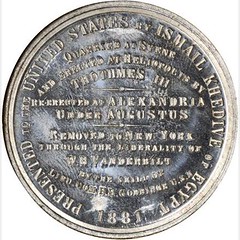
1881 American Numismatic Society Cleopatra's Needle Medal. White Metal. 41.2 mm. Miller-5, Johnson-Unlisted. Prooflike Mint State.
Obv: Eagle over Federal and New York City Arms gazes toward a towering obelisk against a radiant field. Rev: Eleven-line inscription recording the obelisk's erection by Pharaoh Thothmes III at Heliopolis, relocation to Alexandria by Roman Emperor Augustus, and transport to New York in 1881. Egyptian Khedive (Viceroy) Ismail (Ismael Pasha 1830-1895) presented this obelisk to the United States and a group of wealthy New Yorkers led by William H. Vanderbilt financed relocation of the multi-ton ancient stone relic to New York City's Central Park.
Still housed in a pristine descriptive presentation folder personally inscribed on the back to the New York Produce Exchange on June 1, 1882 from noted Lincolniana collector Robert Hewett, Jr., second vice president of the ANS at that time, and a member of the committee responsible for the medal. Hewett is primarily remembered today as the founder of The Circle Of Friends Of The Medallion which produced America's first series of art medals.
This medal and its folder are in remarkably well preserved. This lot also includes what is apparently the top and bottom of the cardboard box in which the folder was originally housed. The top is
embossed DEMPSEY & CARROLL / ART STATIONERS / 46 EAST 14th STREET / UNION SQUARE / NEW YORK. / STORE OF THE MERIDEN CO. (Total: 4 items)
Provenance: From the Michael Druck Collection.
To read the complete lot description, see:
1881 American Numismatic Society Cleopatra's Needle Medal. White Metal. 41.2 mm. Miller-5, Johnson-Unlisted. Prooflike Mint
State. (https://auctions.stacksbowers.com/lots/view/3-6Y0WK)
To read the earlier E-Sylum article, see:
BOOK REVIEW: MEDALLIC ART OF THE ANS, 1865-2014 (www.coinbooks.org/esylum_v18n30a09.html)
Lot 209: 1786 Non Vi Virtute Vici Copper


1786 Non Vi Virtute Vici Copper. Baker-13, Musante GW-07, W-5730. Rarity-6. Small Head. VG-10 (PCGS). CAC.
PCGS has certified just seven of these, in grades ranging from VG-10 (the present coin) to MS-61; the others are in VF-20, VF-25, VF-30, and (2) EF-40. The Mills-Jenks-Eliasberg Mint State example seems to be the best of the survivors, which probably number somewhere around 25 or 30 pieces in all grades. Several are impounded in places like the ANS, Colonial Williamsburg, and the Boston Museum of Fine Arts. This example is at once more worn and more pleasing than a typical specimen. Though a bunch of these were offered in the 1970s, few have been sold at auction in recent years. Since our (Stack's) 2004 Ford sale, we count just four discrete specimens coming to market: the F. Dabney Caldwell specimen, the Eric P. Newman specimen, the Jack Royse specimen, and the present example formerly part of the Henry P. Kendall Foundation Collection.
A rare type steeped in mystery, the Non Vi Virtute Vici coppers are of unknown origin and intent, although they have long been associated with attempts by several individuals to obtain rights to coin coppers for the State of New York (all of which failed for the state legislature never authorized an official coinage). The reverse of these enigmatic pieces bears the inscription NEO - EBORACENSIS, which is similar to the obverse inscription of the Nova Eborac coppers likely produced by John Bailey and Ephraim Brasher in or near New York City.
To read the complete lot description, see:
1786 Non Vi Virtute Vici Copper. Baker-13, Musante GW-07, W-5730. Rarity-6. Small Head.
(https://auctions.stacksbowers.com/lots/view/3-6Y1H8)
Lot 376: Albany Church Penny


Undated (1790) Albany Church Penny. W-8500. With D Added. EF-40 (PCGS). CAC. 121.3 grains. A beautiful example of the most popular American communion token, struck over a very well worn English halfpenny that was still circulating in the Hudson Valley a century after it was made.
A particularly fine example. In our (Stack's) Ford II sale of 2004, we offered specimens of both with D and No D varieties. The With D brought more than the No D, but perhaps not enough more to give this variety its proper premium for rarity. Long assumed to be of about the same rarity, it actually looks like this variety is the rarer of the two by a significant margin.
Michael Hodder recorded just five specimens known to him: the Ford coin, boldly overstruck on a George III counterfeit halfpenny; a specimen in the Partrick collection; one in a well known Rhode Island collection, also overstruck on a George III counterfeit halfpenny; the Robison-Roper coin; and the Picker coin. We can add two to the list, aside from this one. The Breen plate coin for this variety is pedigreed by Breen to a "Pvt. Coll.," but it's actually the ANS coin, ex Howland Wood, and has been there since 1911; it is the only Albany Church penny in the ANS holdings. There was also a newly discovered specimen, a very nice one, sold in Heritage's January 2012 sale for $115,000. That one, like this coin, was struck over an extremely worn William III halfpenny; it was graded PCGS EF-45+.
Since Ford, the Ford specimen has resold in the Heritage January 2007 sale, now graded PCGS VF-35, at $74,750. Other than the present example, we have sold two Albany Church pennies since Ford, though both were the No D variety: one in our (Stack's) 2009 ANA sale graded VG-10 (NGC) and another in our November 2011 sale graded Fine-15 (PCGS) that was boldly overstruck on a (likely counterfeit) 1771 English halfpenny. PCGS has graded an example of this variety on five occasions, though we believe this total to represent at most four specimens, and more likely three.
To read the complete lot description, see:
Undated (1790) Albany Church Penny. W-8500. With D Added. (https://auctions.stacksbowers.com/lots/view/3-6Y0XJ) 
NUMISMATIC NUGGETS: MARCH 26, 2017
1681 Effigies Romanorum
 Effigies Romanorum Imperatorum ex antiquis numismatibus, quae in Thesauro Christinae Reginae adservantur delineatae ... a Julio Caesare, ad Leopoldum semp. Augus. Rome, JJde Rubeis
1681. Imp.Fol. With 166 etched medallions, 164 of them. Portraits of the Roman emperors from Julius Caesar to Franz I. on 56 Bl., On Darst, trimmed and mounted on 15 Bl. Hlwd. 19th century. With blue
dj. With goldprpr. Tit: "The Roman Emperors". (Slightly loosened, lightly rubbed and slightly dry). AKL 4, p. 598. Thieme-B. II, 51. -
Effigies Romanorum Imperatorum ex antiquis numismatibus, quae in Thesauro Christinae Reginae adservantur delineatae ... a Julio Caesare, ad Leopoldum semp. Augus. Rome, JJde Rubeis
1681. Imp.Fol. With 166 etched medallions, 164 of them. Portraits of the Roman emperors from Julius Caesar to Franz I. on 56 Bl., On Darst, trimmed and mounted on 15 Bl. Hlwd. 19th century. With blue
dj. With goldprpr. Tit: "The Roman Emperors". (Slightly loosened, lightly rubbed and slightly dry). AKL 4, p. 598. Thieme-B. II, 51. -
The first (unnumbered) medallion shows an allegory on Rome. The last etching with empty medallion left and cartouche with eagle, with the imprint and date 1681. At least the two last portraitbl. With the numer. Portraits 159-164 are, however, later dated, So that the work in this completeness could not have appeared before 1745 (coronation year Franz I). - 1 sheet loose
To read the complete lot description, see:
100-1Aquila.P.
(www.kiefer.de/auktion_artikel_details.aspx?KatNr=1&utm_source=auctions&utm_content=auktion-100)
Second Issue Five Cent Fractional Note

To read the complete lot description, see:
SECOND ISSUE FIVE CENT FRACTIONAL NOTE
(www.proxibid.com/aspr/SECOND-ISSUE-FIVE-CENT-FRACTIONAL-NOTE/35230931/LotDetail.asp?lid=35230931)
1860's Abraham Lincoln Broken Column Medal


1860's Abraham Lincoln Broken Column Silver US Mint Medal Memorial Token, Julian PR-37 19mm Uncirculated, toned, proof like with some light hairlines.
To read the complete lot description, see:
1860's Abraham Lincoln Broken Column Silver US Mint Medal Memorial Token
(ww.ebay.com/itm/1860s-Abraham-Lincoln-Broken-Column-Silver-US-Mint-Medal-Memorial-Token/382006215388)
1930s Wine Vineyard Medal


THIS SILVER (33.8 GRAMS) VINYARD, WINE GROWING PRIZE MEDAL PARIS, FRANCE. THE MEDAL IS BY CHOBILLON AND WHILE UNDATED IS, WE BELIEVE, FROM SOMETIME IN THE 1930S. THE MEDAL HAS THE WORD "ARGENT" ON THE RIM AS WELL AS THE MAKER'S MARK AND SILVER HALLMARK.
THIS SILVER MEDAL (33.8 GRAMS) IS GRADED A GOOD XF. THE MEDAL MEASURES 41MM. VERY DETAILED REVERSE WITH SOME LIGHT RUBBING TO BOTH SIDES. ATTRACTIVE ORIGINAL PATINA.
To read the complete lot description, see:
FRANCE-FRENCH-PARIS-CA1930S-WINE-HARVEST-AWARD-MEDAL-SILVER
(www.ebay.com/itm/FRANCE-FRENCH-PARIS-CA1930S-WINE-HARVEST-AWARD-MEDAL-SILVER/132130627888)
1941 Honda Gold Medal


A Honda gold Medal issued by the Nippon Kinsofu Gakkai (Japanese Metallurgical Institute) in 1941, awarded to Professor Doctor Friedrich Korber (1887-1944), the 18ct gold medallion depicting the bust of Kotaro Honda and with details of recipient to reverse, 50mm diameter (weight 103.6 grammes), in black leather cloth fitted case and wooden outer box, complete with an obituary of Dr. Korber and with English translation of same
Estimate £3,000 - 4,000
To read the complete lot description, see:
A Honda gold Medal issued by the Nippon Kinsofu Gakka
(www.thecanterburyauctiongalleries.com/Lot/?sale=FA040417&lot=156&id=49698)
1966 World Cup Winners Gold Medal

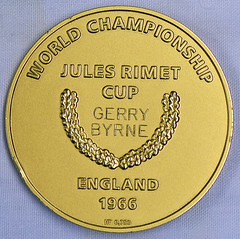
1966 World Cup Winners Gold Medal awarded to Gerry Byrne by FIFA and issued in 2009 to England squad members, stamped HF 0.750 to the reverse World Championship Jules Rimet Cup ‘Gerry Byrne’ England 1966, issued to the remaining England squad after only the starting 11 received medals during the competition. The medals were presented to the players by the Prime Minister at 10 Downing street organised by the FA. The medal party headed straight from Downing street to Wembley Stadium on the England team bus for their match against Andorra 10/06/2009.
Guide Price: £32000.00 - £35000.00
To read the complete lot description, see:
LOT 952 1966 World Cup Winners Gold Medal awarded to...
(www.mullocksauctions.co.uk/lot-704499-1966_world_cup_winners_gold_medal_awarded.html)

STATE DEPARTMENT MEDAL GOLD MEDAL OFFERED
 A rare early 20th Century U.S.A gold Presidential Medal presented by President Thomas Woodrow Wilson "To Mr James Pay, Chief Coxswain of The Kingsdown Lifeboat "Charles
Hargreaves", In Recognition of his Heroic Services in effecting the Rescue on November 20th 1916 of the Master and Crew of the American Steamship Sibiria", 36mm diameter (weight including
bar 32.5 grammes), and a George V Royal National Lifeboat Institution silver Medal awarded to James Pay (voted 8th Dec. 1916), later in leather covered fitted case
A rare early 20th Century U.S.A gold Presidential Medal presented by President Thomas Woodrow Wilson "To Mr James Pay, Chief Coxswain of The Kingsdown Lifeboat "Charles
Hargreaves", In Recognition of his Heroic Services in effecting the Rescue on November 20th 1916 of the Master and Crew of the American Steamship Sibiria", 36mm diameter (weight including
bar 32.5 grammes), and a George V Royal National Lifeboat Institution silver Medal awarded to James Pay (voted 8th Dec. 1916), later in leather covered fitted case
Note: The silver medal awarded to Chief Coxswain James Pay for outstanding gallantry and tremendous skill, courage and resourcefulness during these rescue attempts. Silver medals were awarded by the R.N.L.I to Coxswain William Adams of the Deal Lifeboat, to Coxswain William Stanton and Second Coxswain Robert Holbourn, 73 of The North Deal Reserve Lifeboat, to Coxswain James Pay of The Kingsdown Lifeboat and to Coxswain William Cooper and Second Coxswain Thomas Read of The Ramsgate Lifeboat. In addition to his R.N.L.I silver medal Coxswain James Pay received a special gold Medal from (The American) President Woodrow Wilson
Complete with the details of the heroic rescue of the S.S. Sibiria, 20th November 1916 as detailed by Arthur Micklethwaite in "A Boatman's Tales", and with a copy of The Story in Straits Times, 27th December 1916 worded "Liner Siberia Wrecked - Badly Ashore on The Goodwin Sands" - Message from Deal on November 20th to The Daily Chronicle stated that the American Steamer Siberia was ashore on The Goodwin Sands, and that the great giant waves were slowly battering her to pieces. As far as could be judged on board number about forty including several women passengers clustered on the bridge. Gallant attempts were made by the life-boats to rescue the crew and passengers, but at the time of dispatch of the message they had not succeeded and two life-boats had returned much damaged and with the crews injured.
A Deal boat seized what seemed a favourable opportunity to get alongside the steamer, a huge sea caught her and ripped her sails to shreds and tore the thwart to which the anchor line was fixed clean out of the boat. At the same time she was brought broadside on a filled with water. A similar fate attended a Ramsgate lifeboat, several of whose men sustained broken arms and legs, and she also had to put back. The Siberia belonged to the Pacific Mail Steamship Company, New York - her Gross Tonnage is 11,284.
Estimate £5,000 - 7,000
To read the complete article, see:
A rare early 20th Century U.S.A gold Presidential Medal presented by President Thomas Woodrow Wilson
(www.thecanterburyauctiongalleries.com/Lot/?sale=FA040417&lot=155&id=49697)

SPINK USA OFFERS PAQUET AND WRIGHT MEDALS
Spink USA’s 969-lot sale April 4 and 5 in New York City includes a number of 19th century medals, including two executed by Assistant Mint Engraver Anthony C. Paquet.
Among the lots offered are an 1847 Commonwealth of Virginia medal recognizing Maj. Gen. Winfield Scott’s military service during the War with Mexico; an 1864 Cathedral of St. Peter and St. Paul, Philadelphia medal; an 1860 Japanese Embassy medal; and a silver 1792 silver half disme.

1864 Cathedral of St. Peter and St. Paul Medal by Anthony Paquet

Commonwealth of Virginia medal by Charles Cushing Wright

Japanese Embassy Medal by Anthony Paquet
To read the complete article, see:
Spink USA April auction features Anthony C. Paquet U.S. Mint medals
(www.coinworld.com/news/us-coins/2017/03/spink-usa-offers-19th-century-us-mint-medals-in-april-sale.html)

ARCHIVES INTERNATIONAL SALE 40 ANNOUNCED
CHINESE, U.S. AND WORLDWIDE BANKNOTES, COINS AND SCRIPOPHILY WILL BE OFFERED IN 2 SESSIONS AT PUBLIC AUCTION ON TUESDAY, APRIL 11 th , 2017
The auction will be held by Archives International Auctions, at their offices in Fort Lee, N.J.
 The April auction will feature an extensive collection of Chinese banknote rarities including three different Russo-Asiatic and Russo-Chinese notes that rarely come to auction as well as
additional Selections from the Alexander I. Pogrebetsky Family Archives of rare Chinese banknotes. There is also an impressive and extensive collection of Middle Eastern banknotes and coins featuring
several rare coin and pattern varieties from Jordan that have never been offered previously at auction and are sure to cause considerable excitement among Middle East Coin collectors. An attractive
and desirable group of scripophily, the collecting of stocks and bonds, will be offered as well as a large variety of U.S. banknotes, coins and related material will be part of a two-session public
auction planned for April 11 th by Archives International Auctions, at 1580 Lemoine Avenue in Fort Lee, New Jersey.
The April auction will feature an extensive collection of Chinese banknote rarities including three different Russo-Asiatic and Russo-Chinese notes that rarely come to auction as well as
additional Selections from the Alexander I. Pogrebetsky Family Archives of rare Chinese banknotes. There is also an impressive and extensive collection of Middle Eastern banknotes and coins featuring
several rare coin and pattern varieties from Jordan that have never been offered previously at auction and are sure to cause considerable excitement among Middle East Coin collectors. An attractive
and desirable group of scripophily, the collecting of stocks and bonds, will be offered as well as a large variety of U.S. banknotes, coins and related material will be part of a two-session public
auction planned for April 11 th by Archives International Auctions, at 1580 Lemoine Avenue in Fort Lee, New Jersey.
The auction will be packed with 990 lots of rare and highly collectible Chinese, U.S. and worldwide banknotes, coins, and scripophily. The first session includes 688 lots of Chinese and Worldwide banknotes and coins and begins at 10:30 AM est. The second session includes 300+ lots of U.S. Banknotes, Coins, U.S. and Worldwide Scripophily and Security Printing Ephemera and will begin no earlier than 6:00 PM. For those unable to attend in person, online bidding will be available through the website, www.ArchivesInternational.com .
“We are excited to be able to offer another outstanding assortment of worldwide banknotes, coins and scripophily including many rarities that have never been previously offered at auction. Included in the auction are two advanced collectors' consignments that will be sure to attract serious attention from both collectors and dealers,” said Dr. Robert Schwartz, president of Archives International Auctions.
Dr. Schwartz added, “We're also looking forward to our spring auctions in May and June and are in the planning stages for our summer 2017 auctions. We are still seeking consignments for these and future sales so please contact us.”
Highlights from Session 1, on April 11 th will begin with 230 lots of China, Hong Kong and Japan banknotes and coins with highlights including 12 lots of Imperial Bank of China, 1898 “Peking” Branch issues; a large selection of Republic issues including numerous Bank of Territorial Development notes; a 1953, Peoples Republic, 3 Yuan P-868 is offered in high grade and is rarely seen this nice; 11 lots of fancy Solid Serial Numbers notes are included on 1999 and 2005 Peoples Bank of China Issues; an exciting Deutsch-Asiatische 1907 “Peking” rarity is offered; two different Russo- Asiatic banknote rarities are included with an extremely attractive and rare 2 Gold Fen issue from Kuld’Sha, Chugchak & Kashgar and a Russo- Chinese “Shanghai” 50 Mexican Dollars Color Trial Specimen is offered.
Very attractive and rare Military and Private issues are offered including two high grade Sin Chun Bank notes; An extremely rare “Tientsin Merchants Association” Circulating Note-Envelope with 10,000 Rubles of Russian notes inside, that were meant to be circulated in Tientsin and evidently were guaranteed by the issuer on the outer envelope with the interior including 10 notes of 1000 rubles each of Russia, P-37. This is a unique usage of mixed Russian currencies circulating in China and is the first we have ever seen and will attract serious interest by Russian and Chinese collectors.
The Session 1 world note and coin section includes over 450 banknotes and coins. Some of the many highlights in this section include and exciting collection of over 25 different Thomas De La Rue Specimen and Essay banknotes from issues rarely if ever seen in this format. Included are numerous British Colonies notes such as Fiji, ND (2007) Essay Specimen design for a $100 note like P-114sp with slight differences. Also included are 45 lots of Canada banknotes including, issued, specimens and proofs; 4 different 2006 to 2008 Bhutan Essay banknotes; an issued Danish West Indies, 5 Francs, 1905 issue; 3 different high grade Republik Indonesia 1948 Essay Specimens; 2 different Central Bank of Kazakhstan specimen essays never offered previously at auction and are very attractive; A high grade specimen set of 5 notes from the 1973, 1976 ND Issue of the U.A.E. is offered and is sure to attract attention as well as hundreds of other desirable and rare banknotes.
World coins includes an old time Great Britain collection with highlights including a 1904, 2 Shillings Edward VII graded MS 62; Iraq includes several rare and desirable coins including a 1932, 1 Riyal, Faisal I in Uncirculated and rarely seen in this high of condition; Jordan is represented by numerous rare varieties highlighted by a Hussein bin Talal, 1952-1999 Pattern ½ Dinar issued in 1996 with an earlier date and is the first time this rarity has been offered at auction. Numerous highlights from Palestine, Poland, Qatar and other countries round out this exciting auction.
Session 2 includes over 300 lots of U.S. Banknotes, Scripophily, Coins, Security Printing Ephemera and historic documents. The scripophily section of over 90 lots features an 1871 American Bank Note Company issued and cancelled stock certificate as well as numerous exciting and attractive bonds and shares in many areas from mining to railroad to automobiles ending with 14 lots of Liberty Loans and Government related bonds and documents. Colonial banknotes as well as obsolete banknotes are included featuring numerous highlights such as 2 “Sam Houston” signed 1838 Government of Texas $50 notes; a 1780 Commonwealth of Virginia land Office Treasury Warrant for 580 acres of land; a Francis Hopkins, 1779 signed 3 rd Bill of Exchange; rare proof banknotes from Connecticut, Maryland, Maine, New Jersey and other locations as well as dozens of other interesting and desirable items. The auction ends with 30 lots of U.S. coins.
The auction will feature hundreds of additional rare and desirable banknotes, coins, and scripophily in every price range, for the beginner to the advanced collector. Previews will be held at Archives International Auctions offices Wednesday to Friday, April 5 th to 7 th t from 10 AM to 5 PM and by appointment. For an appointment call 201-944- 4800 or email info@archivesinternational.com .
The online catalogs for the April 11 th sales are on Archives International Auctions’ website and can be viewed via the Archives International live bidding platform. It can also be viewed as a virtual catalog or downloadable .pdf on their website. To pre-register for live internet bidding, log on to the Archives International Auctions website, at www.ArchivesInternational.com .
Archives International Auctions is currently seeking quality consignments for future auctions and is looking for U.S. and worldwide banknotes, coins, stocks, bonds, stamps, postal history, historic ephemera, autographs, and documents to buy outright. To sell or consign one piece or an entire collection, please call AIA at (201) 944-4800; or e-mail them at info@archivesinternational.com .
You may also write to Archives International Auctions, at 1580 Lemoine Ave., Suite #7, Fort Lee, NJ 07024 U.S.A. To learn more about Archives International Auctions and the auctions planned for April 11th, 2017, log on to www.ArchivesInternational.com .
SELECTIONS FROM ARCHIVES INTERNATIONAL SALE 40
Lot 52: China Bank of Territorial Development Shanghai Branch

Shanghai, China. $5, P-567n (S/M#C165-4f), Issued banknote, purple on yellow, PMG graded About Uncirculated 58 EPQ with bright colors, sharp corners and large even margins that only enhance this attractive note. S/N S0061125, BEPP. Rarely seen in this high of grade and tied with 1 other as the finest known in the PMG census. (Alexander I. Pogrebetsky Family Archives, Part 2).
To read the complete lot description, see:
Bank of Territorial Development, 1914 Shanghai Branch Issue.
(http://auction.archivesinternational.com/Bank-of-Territorial-Development-1914-Shanghai-Branch-Issue_i26891422)
Lot 101: Deutsch-Asiatische Bank 1907 Peking Branch Banknote
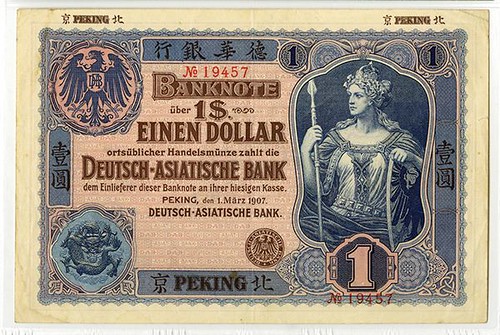
Peking, China. $1, P-S272r S/MT101, Remainder banknote, Brown text on dark blue-gray border and vignette with pink underprint, Germania at right, arms at top left, coiled dragon lower left, back brown text on blue, pink and m/c underprint, cameo portraits at left and right. S/N 19457, PMG graded Extremely Fine 40. Rare and very attractive note. G&D. This is the finest graded example of the 2 graded in the PMG census.
To read the complete lot description, see:
Deutsch-Asiatische Bank, 1907 Peking Branch Issue Rarity.
(http://auction.archivesinternational.com/Deutsch-Asiatische-Bank-1907-Peking-Branch-Issue-Rarity_i26891471)
Lot 102: Russo-Asiatic Bank Note

Russo-Asiatic Bank in Kuld'sha Chugchak & Kashgar, 1913-1917, Issued Banknote
China, issued note, 2 Gold Fen, 1913-1917, P-S480, S/M# O5-51, PMG graded Very Fine 30 with comment "Ink Stamp, Annotation", BWC. Very rare especially this nice.
To read the complete lot description, see:
Russo-Asiatic Bank in Kuld'sha Chugchak & Kashgar,
1913-1917, Issued Banknote (http://auction.archivesinternational.com/Russo-Asiatic-Bank-in-Kuld-sha-Chugchak-Kashgar-1913-1917-Issued-Banknote_i26891472)
Lot 173: Pack of Russian Ruble Banknotes used in China
 Tientsin, China, 10,000 Rubles, Russia, P-37, package of 10 issued banknotes, mostly AU to Uncirculated and sequential, with seals and previously enclosed in an envelope with Chinese text
for a total of 10,000 Rubles for usage in Tientsin China. Prepared by Tientsin Merchants Association for the usage in China. The envelope has purple oval seals with English "Kung I Hui Hua"
overprints, The red text on the back cover describes the purpose and regulation of this package, and the small seal reads "ten thousand". Unique usage of Russian banknotes to circulate in
China.
Tientsin, China, 10,000 Rubles, Russia, P-37, package of 10 issued banknotes, mostly AU to Uncirculated and sequential, with seals and previously enclosed in an envelope with Chinese text
for a total of 10,000 Rubles for usage in Tientsin China. Prepared by Tientsin Merchants Association for the usage in China. The envelope has purple oval seals with English "Kung I Hui Hua"
overprints, The red text on the back cover describes the purpose and regulation of this package, and the small seal reads "ten thousand". Unique usage of Russian banknotes to circulate in
China.
To read the complete lot description, see:
Tientsin Merchants Association, Pack of
10,000 Russian Ruble Banknotes used in China, ca.1917 Tients
(http://auction.archivesinternational.com/Tientsin-Merchants-Association-Pack-of-10-000-Russian-Ruble-Banknotes-used-in-China-ca-1917-Tients_i26891543)
Lot 340: St. Thomas, Danish West Indies Banknote
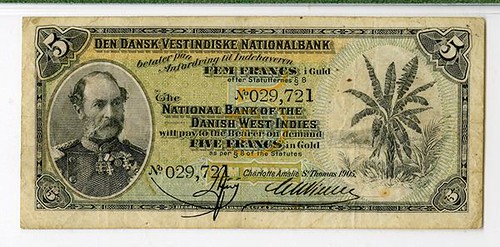
St. Thomas, Danish West Indies, 1905, 5 Francs in Gold, P-17, Issued banknote, Black on green, gray and orange, King Christian IX at left, palm tree at right, back brown, S/N 029,721, PMG graded Very Fine 25 NET with note of small rust spots. Rare banknote in any condition and rarely seen issued.
To read the complete lot description, see:
National Bank of the Danish West Indies 1905 Issue Banknote.
(http://auction.archivesinternational.com/National-Bank-of-the-Danish-West-Indies-1905-Issue-Banknote_i26891710)
Lot 790: Third Bill of Exchange, 1779
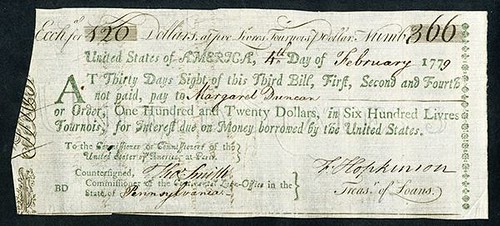
Pennsylvania and Paris, France. 3rd of Exchange for 120 Dollars = 600 Livres, dated February 4th, 1779, to be paid to a Margaret Duncan, in Six Hundred Livres Tournois for interest due on money borrowed by the United States government. Signed by Francis Hopkinson, who was a signer of the Declaration Independence and a lawyer, judge, and author. He was the first scholar and first Graduate of the College of Philadelphia, which his father, along with good friend Benjamin Franklin, played a role in chartering. Annotations on back including signatures and endorsements of John Barnes and William Bingham. Attractive Very Fine condition. Rare.
To read the complete lot description, see:
United States of America, Third Bill of
Exchange, 1779, Signed by Francis Hopkinson - Signer of the
(http://auction.archivesinternational.com/United-States-of-America-Third-Bill-of-Exchange-1779-Signed-by-Francis-Hopkinson-Signer-of-the_i26892160)

RARE COENWULF PENNY FOUND BY METAL DETECTORIST
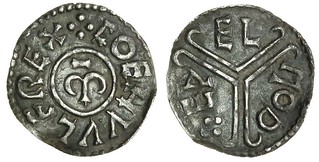 A RARE 1,200-year-old coin found in Hampshire is set to fetch about £700 at an auction next week.
A RARE 1,200-year-old coin found in Hampshire is set to fetch about £700 at an auction next week.
The silver penny, found by a metal detectorist at Broughton in January, was made at the Canterbury Mint some time between 796 and 821, during the reign of Coenwulf, King of Mercia.
It is now expected to sell for between £600 and £800 when it is auctioned at Spink in Bloomsbury, London, next Wednesday.
The coin may have lain in the earth undisturbed for more than 1,000 years.
Auctioneers Spink describe the coin as “a field find” and although it has “soil deposits in recesses and minor flan distortion” it is in “otherwise good very fine” condition.
The penny is a Tribtrach type, so-called because of its distinctive design featuring three lines meeting at the centre.
The coin also features the name of Ethelmod, the so-called moneyer whose job it was to check the weight, fineness and purity of Canterbury coins during the reign of Coenwulf.
Few of this type of penny are known to have survived.
Gregory Edmund, a specialist in the coins department at Spink, said: “Currently about two dozen examples of this particular type by the moneyer Ethelmod of the mint at Canterbury are recorded in the latest publications on the coinage of this period.”
To read the complete article, see:
Silver penny found by a metal detectorist at Broughton was made at
the Canterbury Mint sometime between 796 and 821 (www.dailyecho.co.uk/news/15170225.Rare_1_200_year_old
_coin_up_for_auction_after_being_found_in_Hampshire_field/#)

JERUSALEM BYZANTINE COIN FIND
A buried treasure of nine well-preserved bronze coins found by archeologists during an excavation near Route 1 serves as evidence of the Persian invasion of Jerusalem at the end of the Byzantine period, the Israel Antiquities Authority announced on Sunday.
According to the Antiquities Authority, the coins, from the 7th century CE, bearing the images of Byzantine emperors, were unearthed in June during salvage excavations conducted by the authority as part of widening the highway near Ein Hemed, roughly 7 kilometers west of Jerusalem.
The images of Byzantine emperors Justinian (483-565 CE), Maurice (539-602 CE) and Phocas (547-610 CE), all wearing military garb and carrying a cross can be seen on the coins.
Annette Landes-Naggar, director of the excavation on behalf of the Antiquities Authority, said the coins were found bundled in a cloth purse deep in the ground by the wall of an ancient winepress.
“The cache was buried adjacent to an area of collapsed large stones,” she said. “It appears that the owner hid them when there was danger, hoping to return to pick them up. But now we know he was unable to.”
“Apparently, this was during the time of the Persian Sassanid invasion, around 614 AD,” she added, noting that the invasion was among the factors that ended the reign of the Byzantine emperors in Israel.
“Fearing the invasion, residents of the area who felt their lives were in danger buried their money against the wall of a winepress,” Landes-Naggar said. However, “the site was abandoned and destroyed.”
To read the complete article, see:
RARE 1,400-YEAR-OLD BRONZE BYZANTINE-ERA COINS FOUND NEAR JERUSALEM
HIGHWAY (www.jpost.com/Israel-News/Rare-1400-year-old-bronze-Byzantine-era-coins-found-near-Jerusalem-highway-484582)
MONTGOMERY BLAIR RUSSIAN WIRE MONEY
In his numismatic diary last week, Tom Kays wrote:
Gene gave me to hold for Eric, the original container for a hoard of Russian Wire Money assembled long ago that Eric studied in his youth.
The 3 inch, hand folded envelope seems to be vellum rather than paper, with old quill and ink writing. The “paper” is without foxing and reads in accented English, “98 Old Russian Silver Monney’s of XVI & XVII Centuries.” Inside are smaller, folded envelope “tubes” of the same material reading: “25 Kopeika’s John’ I the Terrible,” “1 Denga & 15 Kopeika’s Bozys Hofunov,” in the fold, and “20 Kopeika’s of the ‘Zar Theodor.” It is a most curious old coin holder.

You bet I remember those Russian "wire" coins! I was part timing for Gene at the time at his shop on S. Union St. They came to Gene in 1993 wrapped in those little envelopes and I recorded them as coming out of the collection of Montgomery Blair, Lincoln's Postmaster General.
There were at least 50 coins in the group, all from the reigns of Ivan IV Vasilievich "the Terrible," his son Fyodor I Ivanovich, Boris Godunov, and Vasily IV Shuiski, along with a stray coin or two of Mikhail I and Peter I "the Great." At the time, I was actually studying Medieval Russian coins and was writing a thesis as part of a college independent study.
I bought 14 of the coins at the time and they remain part of the core of my medieval collection to this day. The neatest coin in the group is a dramatically double struck kopeck of Ivan as Tsar (Melnikova 22-26, Kleshchinov-Grishin 80). I have several hundred examples now, which also includes the earlier feudal pieces and also the coins of the Juchid Ulus (Golden Horde) and the later Giray khanate of Crimea. Attributing those coins was one of those singular numismatic events that really shaped my collecting and scholarship. That is a hell of a gift from one of my long time mentors.
As a postscript, I never got the thesis in any sort of shape to publish, though I did get an A for it (I still have it and used the coins I bought from that collection for illustrative purposes). There have been many more discoveries since then, plus Dzmitry Huletski has been doing yeoman's work publishing great catalogs in English and Russian on the topic, making a formerly daunting subject matter accessible.
Here are pictures of the Montgomery Blair Russian coins from my collection. The coins were in little packets contained in that big packet.


The coins are from left to right:
Row 1: Ivan IV as Great Prince (1533-1547)
Melnikova 9-12; KG 75
Melnikova 14-17; KG 76
Melnikova 13-16; KG 71
Row 2: Ivan IV as Tsar (1547-1584)
Melnikova 15-18; KG 57
Melnikova 16-19; KG 59
Melnikova 19-23; KG 77
Melnikova 22-26; KG 80
Melnikova 21-25; KG 79
Melnikova 35-27; KG 93
Row 3: Fyodor I (1584-1598)
Melnikova 1-1; KG 105
Melnikova 6-4; KG 123
Melnikova 5-2; KG 137
Row 4: Boris Godunov (1598-1605)
Melnikova 4-2; KG 173
Melnikova 6-1; KG 181


To read the earlier E-Sylum article, see:
TOM KAYS' NUMISMATIC DIARY: MARCH 14, 2017 (www.coinbooks.org/v20/esylum_v20n12a22.html)
THE BOOK BAZARRE
MORE ON THE NETHERLANDS LION DAALDER


Kavan Ratnatunga of Sri Lanka writes:
I found that the 2017 Leewendaalder is sold at
https://www.knm.nl/Herslag-Leeuwendaalder-2017-Zilver-Proof/nl/product/9392/
Pity it is just Bullion and not even NCLT. It has a 0,999 Silver rather than 0.750 Silver. It has a weight of 31.1 grams rather than 27.68 of original and a crown size diameter of 38.7 mm rather than 40.5 mm. So is it just a way of marketing Bullion at 3.8 times the market value of Silver and 1.7 times in Gold. Can it be called a replica ?


Original Silver Leeuwen Daalder
http://coins.lakdiva.org/netherlands/1644_wes_lion_daalder_ag.html

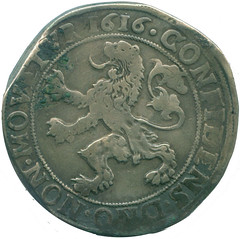
A contemporary counterfeit from Massachusetts
http://coins.lakdiva.org/netherlands/1616_tra_lion_daalder_ag.html
To read the earlier E-Sylum article, see:
THE NETHERLANDS: “LION DAALDER” REBORN (www.coinbooks.org/v20/esylum_v20n11a24.html)
STACKS BOWERS OFFERS CHOPMARKED TRADE DOLLARS
The silver Lion Dollar was an important world trade coin, as was the much later U.S. Trade Dollar, which was minted specifically for that purpose. In the Orient, merchants and moneychangers tested the coins passing through their hands to ensure they had the proper weight and fineness of silver. To attest to their evaluation, they stamped their symbol (called a countermark or chopmark) on the coin.
In a note Colin Gullberg, editor of Chopmark News, the newsletter of the Chopmark Collectors Club wrote the following email to club members on March 13, 2017.
Stacks Bowers auctions is selling an important collection of U.S. trade dollars in their upcoming March 2017 Baltimore Sale. There are 44 chopped U.S. trade dollars, apparently all from the same collection, including a very scarce 1878-CC coin. James Sneddon and David Reimer, two specialist collectors, estimate that there are probably about 10-12 pieces in existence. In an old issue of the newsletter (March 2005, vol. 11 no. 1) James Sneddon wrote an article of the 8 examples of the 1878-CC known to him. This appears not to be one of those 8.
You can view the 44 coins here:
https://auctions.stacksbowers.com/auctions/3-6Y8CA?
view=list&sort=relevance&is_mixed_lot=sometimes&limit=48
&search=chopmark+Trade+dollar
Is this a collection owned by one of our members? I would be interested in knowing.
Lot 4349: 1878-CC Trade Dollar


1878-CC Trade Dollar--Chopmark--VF-35 (PCGS).
By far the rarest circulation strike in the trade dollar series, the 1878-CC was produced to the extent of just 97,000 pieces. These coins were struck before Secretary of the Treasury John
Sherman's order of February 28, 1878 to cease paying out trade dollars for bullion reached the Carson City Mint. On July 19, 1878, the Mint melted 44,148 undistributed trade dollars, almost all
of which were dated 1878-CC. The net mintage for this issue, therefore, is probably close to 52,852 coins. Most examples that were distributed probably remained in the United States, for the 1878-CC
is also the rarest chopmarked trade dollar.
According to research conducted by James Sneddon (and kindly related to your cataloger by Colin James Gullberg), only eight specimens are positively confirmed to exist, although there are estimates of a dozen or so examples extant. Indeed, as this specimen does not correspond to seven of the examples reported by Sneddon (we have not been able to locate a picture of the eighth example on his list), it may be a newcomer whose prior provenance is unknown to researchers. A highlight of the present collection, and a coin that would serve as a centerpiece in a specialized cabinet.
To read the complete lot description, see:
1878-CC Trade Dollar--Chopmark--VF-35 (PCGS). (https://auctions.stacksbowers.com/lots/view/3-6YBM7)
Lot 4321: 1874-S Trade Dollar


1874-S Trade Dollar--Chopmark--MS-62 (PCGS).
A satiny, generally brilliant example with a few swirls of light russet patina here and there around the reverse border. The strike is generally sharp, although the S mintmark is lightly impressed
and faint. A shallow chopmark is present on the obverse at Liberty's knees, while a sharper one is readily evident in the upper reverse field behind the eagle's head. Widely used in commerce
in the Orient as an issue, the 1874-S is one of the more numerous chopmarked trade dollars in today's market.
To read the complete lot description, see:
1874-S Trade Dollar--Chopmark--MS-62 (PCGS). (https://auctions.stacksbowers.com/lots/view/3-6YC0Q)
Lot 4311: 1873-CC Trade Dollar
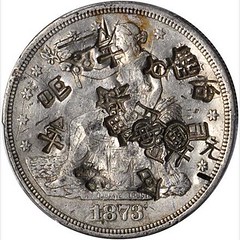

1873-CC Trade Dollar--Chopmark--EF-40 (PCGS).
An extensively chopmarked example, numerous examples of which are present on the obverse with three or four additional ones evident around the reverse periphery. Central detail is largely obscured on
both sides, as a result, as are some of the peripheral features. The CC mintmark is faint, yet discernible with patience, while the date remains clear and bold. Isolated swirls of sandy-orange patina
interrupt an otherwise uniform silver gray appearance. A second example of this scarce CC-mint trade dollar issue, one that is nonetheless relatively plentiful chopmarked due to extensive commercial
use in the Orient.
To read the complete lot description, see:
1873-CC Trade Dollar--Chopmark--EF-40 (PCGS). (https://auctions.stacksbowers.com/lots/view/3-6YC5S)
For more information about the Chopmark Collectors Club, see:
www.chopmarks.org

ORDER OF THE BRITISH EMPIRE MEDAL FOUND
 NEW England police are appealing for public help to find the owners of a rare medal found in Armidale.
NEW England police are appealing for public help to find the owners of a rare medal found in Armidale.
Detectives have been trying to find the owner of the Order of the British Empire medal, which was found earlier this month.
Investigators believe the medal could belong to someone residing further afield in the New England.
The Order is usually granted by the government in the United Kingdom and awarded by the current king or queen to individuals who have excelled in the fields of arts, science, public services or in charitable areas.
The medal was found inside a black case, but has no name inscribed in it.
“The medal is awarded for contributions to the arts and sciences, work with charitable and welfare organisations, and public service outside the Civil service,” a New England police spokesperson confirmed.
Police are urging anyone with information on the rightful owners to contact Armidale detectives on 6771 0699.
To read the complete article, see:
New England detectives appeal for help to find owner of Order of the British Empire award found in
Armidale (www.armidaleexpress.com.au/story/4545301/search-for-rare-medals-owner/?cs=471)
To read the earlier E-Sylum article, see:
JOHN LENNON'S RETURNED MEDAL FOUND IN ROYAL VAULT (www.coinbooks.org/esylum_v12n02a19.html)
MORE ON THE NEW ONE POUND COIN
The new £1 coin comes into circulation this month, signalling the beginning of the end for the round pound, which will be completely phased out by 15 October.
If you're struggling to make heads or tails of the change, here's what you need to know, including what to do with your old coins and what it means for those supermarket trolley key fobs.
The new £1 coin is about the the same size as the old one but has 12 edges and is gold and silver.
It features a hologram where the "£" symbol changes to the number "1" when viewed from different angles.
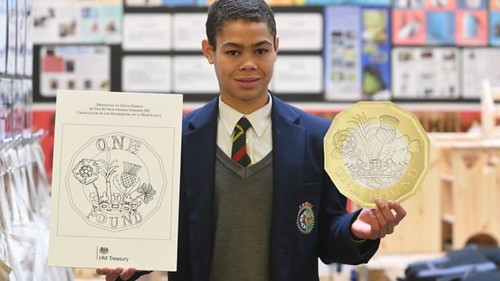
Schoolboy David Pearce drew the "tails" design for the new £1 coin
The "tails" side was drawn by schoolboy David Pearce, who in 2015 created a design of the four plants that represent the UK's four nations. He said he "spent a lot of time researching what coin designs looked like and what sort of designs would represent all parts of the UK" before drawing a leek, thistle, shamrock and rose coming out of a crown.

Here's a nice shot of a royal Mint employee examining on the the new coins. Cool shirt - do they sell them online? -Editor
Another nice part of the article is an interview with ex-pat coin dealer Richard Lobel, who operates a coin shop near the British Museum. He offers sound advice to potential investors and collectors. -Editor
Old £1 coins could become collectible when they cease to become legal tender, according to experts.
"The end of the round pound means many people will want a complete collection from 1983 to today," explains London dealer Richard Lobel, of Coincraft.
He says coins in "brilliant uncirculated condition" are desirable but more as souvenirs than an investment.
"They're difficult to get because nobody puts them aside, after all they are £1 not a penny. But don't expect them to rocket in value."
Mr Lobel also advised people to save their new coins, which could become collectors' items.
"Lots of people save a coin in the first year of issue, but fewer in the second and in the third year fewer still," he says.
"Put a pound away every year and build up a little collection."
To read the complete article, see:
New £1 coin: What do you need to know about the end of the round pound? (www.bbc.com/news/uk-39278501)
LIBERIA STRUGGLES TO REPLACE WORN BANKNOTES
 Since the new banknotes issued by the Central Bank of Liberia came into circulation in October of last year, residents of River Cess have continued to struggle with mutilated notes.
Since the new banknotes issued by the Central Bank of Liberia came into circulation in October of last year, residents of River Cess have continued to struggle with mutilated notes.
The bank has ostensibly distributed the notes to replace mutilated and damaged notes in addition to improving security features to reduce counterfeiting. But those benefits have not reached River Cess citizens.
Recently, several civil servants who went to receive their salaries at the River Cess Bank expressed disappointment in the bank for giving them mutilated banknotes.
David Thompson, a classroom teacher, said because of the condition of the notes, he prefers leaving the money at the bank rather than taking it home.
“It is better for me to leave the money here than for me to carry it home because everything is rotten,” Thompson said. “We are suffering because [there is] only one bank here. If there were more banks here, [the bankers] would not be treating us like this.”
“Anytime we come here for pay, they always gave us [torn] money,” Esther said. “Today is even worse because all the money is spoiled.”
At the bank, some tellers were observed leaving their windows for extended periods of time, making the customers wait in line. The manager of the bank, John Teah, said it was necessary for tellers to do this because “the tellers have to go and pick among the money before paying the people.”
The River Cess Bank, a sub-branch of Afriland Bank, is the only banking institution in the county through which the Government of Liberia pays all civil servants.
The bank, according to the manager, does not have adequate services to escort larger sums of money, therefore it only transports smaller amounts, resulting in the scarcity of new notes.
To read the complete article, see:
Civil Servants Fed Up With Mutilated Banknotes at River Cess Bank
(www.bushchicken.com/civil-servants-fed-up-with-mutilated-banknotes-at-river-cess-bank/)
CHINA BUS COMPANY PAYS DRIVERS SMALL CHANGE
 A bus company in eastern China has paid its drivers using small change in order to avoid taking a huge stockpile of coins to the bank.
A bus company in eastern China has paid its drivers using small change in order to avoid taking a huge stockpile of coins to the bank.
About 200 members of staff at the Baoying Automobile Transport Company were given bags containing mainly 1-yuan coins, popular news site Jiangsu Net reports. The company, which operates in Jiangsu Province, saw a big rise in passenger numbers over the Chinese New Year holiday in January. Many of them preferred to pay in cash instead of using travel cards, union head Gu Fengyun tells the site.
That left managers pondering how to deal with all the cash. Rather than lug it all to the bank to be deposited, they decided to offload coins worth about 200,000 yuan ($30,000; £23,000) onto their employees as wages. The company says the alternative - moving, counting and processing the small change - would have required "a lot of manpower and equipment" both from its own staff and those at the bank.
But the decision has left some drivers unhappy. "Yes it's money, but it's inconvenient to go shopping while carrying round a bag of heavy coins," one driver says. Another explains that staff received differing amounts in small change - some got 300 yuan, others had to deal with coins worth 1,000 yuan.
They may not have to worry, though, as after the story made headlines the local branch of the People's Bank of China got in touch with the bus company to offer a solution. An official tells Yangzhou News that many companies don't realise that commercial banks in the region have coin-counting machines, and they would be happy to exchange the weighty wages for lighter banknotes.
To read the complete article, see:
China bus company pays drivers in small change (www.bbc.com/news/blogs-news-from-elsewhere-39342759)
NEW YORK PUBLIC LIBRARY UNDERGROUND STORAGE
John Lupia writes:
Another reason my numismatists should be deeply involved in stamps is reading The Philatelic Literature Review, which had the story about the APS library move, and others including the NYPL. I thought NBS members and E-Sylum readers might like this.
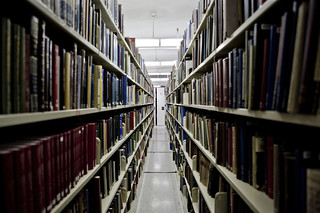 This summer, several times a week, a 30-foot truck filled with rough wooden shelves of books has arrived early in the morning at the New York Public Library’s flagship research library.
Each truckload contains thousands of books, which have been sitting for the past three years at a storage facility upstate.
This summer, several times a week, a 30-foot truck filled with rough wooden shelves of books has arrived early in the morning at the New York Public Library’s flagship research library.
Each truckload contains thousands of books, which have been sitting for the past three years at a storage facility upstate.
Now, 1.5 million books are migrating home, although not to the shelves they once occupied, in the library’s old stacks beneath the Rose Main Reading Room. From the loading dock, the shelves are moved through the maze below the library, until they are two levels below the ground, underneath Bryant Park, which stretches like a lawn before the Beaux-Arts building.
In this subterranean section of the library, you can accidentally walk a city block if you don’t plan right. The basement corridors pass by black pillars that carry the weight of the main reading room and by the stonework from the reservoir that once held the city’s drinking water. On the floor, red and yellow arrows guide the way, to a door through which only a few dozen people are allowed to pass.
“We want to keep our collection safe,” says Johannes Neuer, the library’s director of customer experience, who’s in charge of the books’ big move back to the library. “Once we go to the second level, you’ll understand why it’s very important that only people who know what they’re doing are allowed in the space.”
It is a beautifully cool 65 degrees down here, with 40 percent relative humidity, and there’s a new electric trolley system, in which books can be sent off to reading rooms upstairs in bright red carts. Most importantly, there is space for 2.5 million books.
This underground lair of books was part of a resolution to a tumultuous dispute over the library’s future.
To read the complete article, see:
The New York Public Library is Moving 1.5 Million Books to an Underground
Lair (www.atlasobscura.com/articles/the-new-york-public-library-is-moving-15-million-books-to-an-underground-lair)
To read earlier E-Sylum articles, see:
NEW YORK PUBLIC LIBRARY UNVEILS BOOK TRAIN (www.coinbooks.org/esylum_v19n39a32.html)
NEW YORK PUBLIC LIBRARY READING ROOM NOW READY (www.coinbooks.org/v20/esylum_v20n08a37.html)
BEP LAUNCHES NEW SOCIAL MEDIA ACCOUNTS
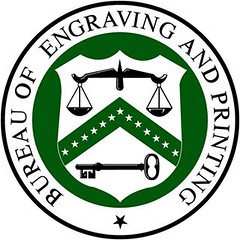 The Bureau of Engraving and Printing (BEP) on Monday launched its official Twitter and Facebook channels – @USMoneyfactory – with the aim of increasing the accessibility and availability of
BEP news. BEP’s website, moneyfactory.gov, remains our primary channel of communication.
The Bureau of Engraving and Printing (BEP) on Monday launched its official Twitter and Facebook channels – @USMoneyfactory – with the aim of increasing the accessibility and availability of
BEP news. BEP’s website, moneyfactory.gov, remains our primary channel of communication.
“I am very excited to use these platforms to highlight the great work that happens at BEP every day,” said Director Len Olijar. “There is so much to share about our nation’s currency and the U.S. currency manufacturing process. We want to make sure that information about our important mission to develop and print U.S. currency is more accessible to a wider audience.”
 In addition to posting the latest news and information from BEP, the Bureau’s social media updates will also feature artifacts and other information from BEP’s Historical Resource Center.
BEP will also post security feature awareness tips, Tour and Visitor Center updates, educational videos, and press releases.
In addition to posting the latest news and information from BEP, the Bureau’s social media updates will also feature artifacts and other information from BEP’s Historical Resource Center.
BEP will also post security feature awareness tips, Tour and Visitor Center updates, educational videos, and press releases.
Follow us on Twitter @USMoneyfactory and check for updates on Facebook at https://www.facebook.com/USMoneyfactory .
To read the complete article, see:
Bureau of Engraving and Printing Launches New Social Media Accounts (www.moneyfactory.gov/pressrelease32317.html)
FEATURED WEB SITE: MONEY GRAFFITI
This week's Featured Web Site is Money Graffiti, a place for images of paper money that people have written or drawn on.Welcome to moneygraffiti.com, the website dedicated to the proposition that all bills may be created equal, but in circulation they take on a life of their own. What people put on their cash not only tells a tale but proves that money does talk! Here's the place to hear what it's saying.

http://moneygraffiti.com/




